21 Abstract Art Compositions with Examples
Uncover the essence of abstraction with a curated selection of 21 compositions, providing inspiration from a range of creative examples.
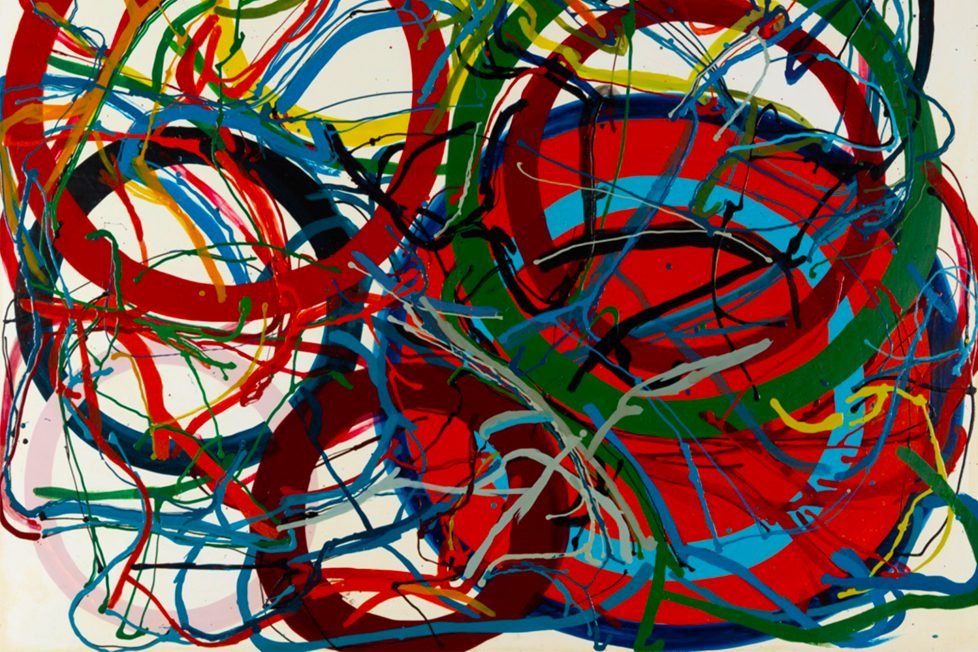
Uncover the essence of abstraction with a curated selection of 21 compositions, providing inspiration from a range of creative examples.

Table of Contents
ToggleAbstract art, known for its departure from direct representation, relies on the creative arrangement of visual elements such as lines, shapes, and colors to convey meaning and emotion. This article presents a look at twenty-one distinct compositional styles, each illustrated with examples from renowned artists. The aim of this exploration is to demystify the abstract art genre, revealing the depth and diversity of compositions that lie beyond the surface of these intriguing artworks.
The cruciform composition in abstract art is an arrangement that employs intersecting lines and shapes, forming a structure reminiscent of a cross. This composition, far from being a purely religious or symbolic reference, is used by artists to create a sense of stability, balance, and in some cases, a spiritual undertone. It leverages the inherent power of the cross’s geometry to evoke various emotions and themes.
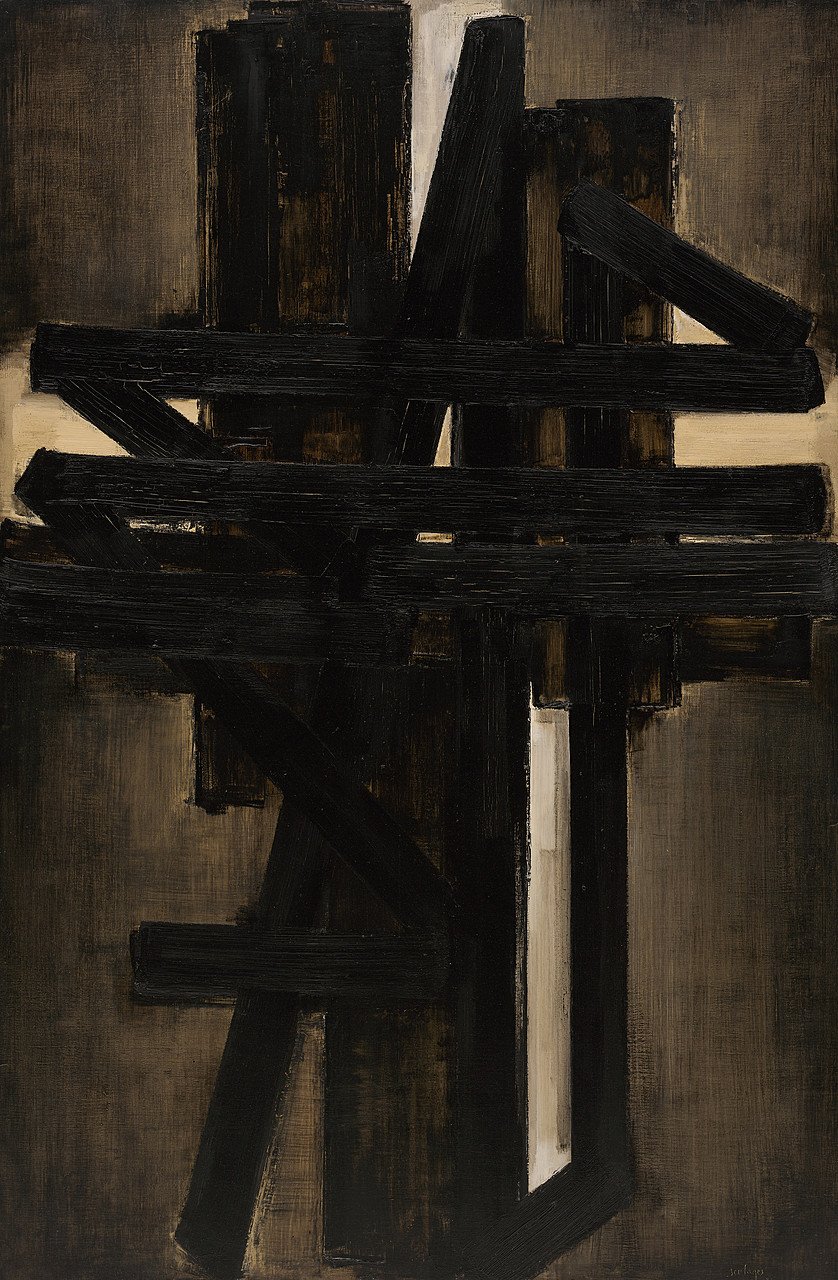
Pierre Soulages’ “Painting, 195 x 130 cm, May 1953” is a prime example of the cruciform composition. In this work, Soulages connects vertical and horizontal brushstrokes with oblique lines, creating a composition that suggests a cross. Importantly, Soulages does not intend for this painting to be interpreted as a religious symbol; rather, it is an exploration of geometric form. He accentuates the cruciform shape with rectangular windows of light sharply cut into the background, creating an effect reminiscent of light filtering through a church window. This use of light, a central theme in Soulages’ work, deepens the black hues and adds a sense of solidity, reminiscent of Rembrandt’s chiaroscuro technique.
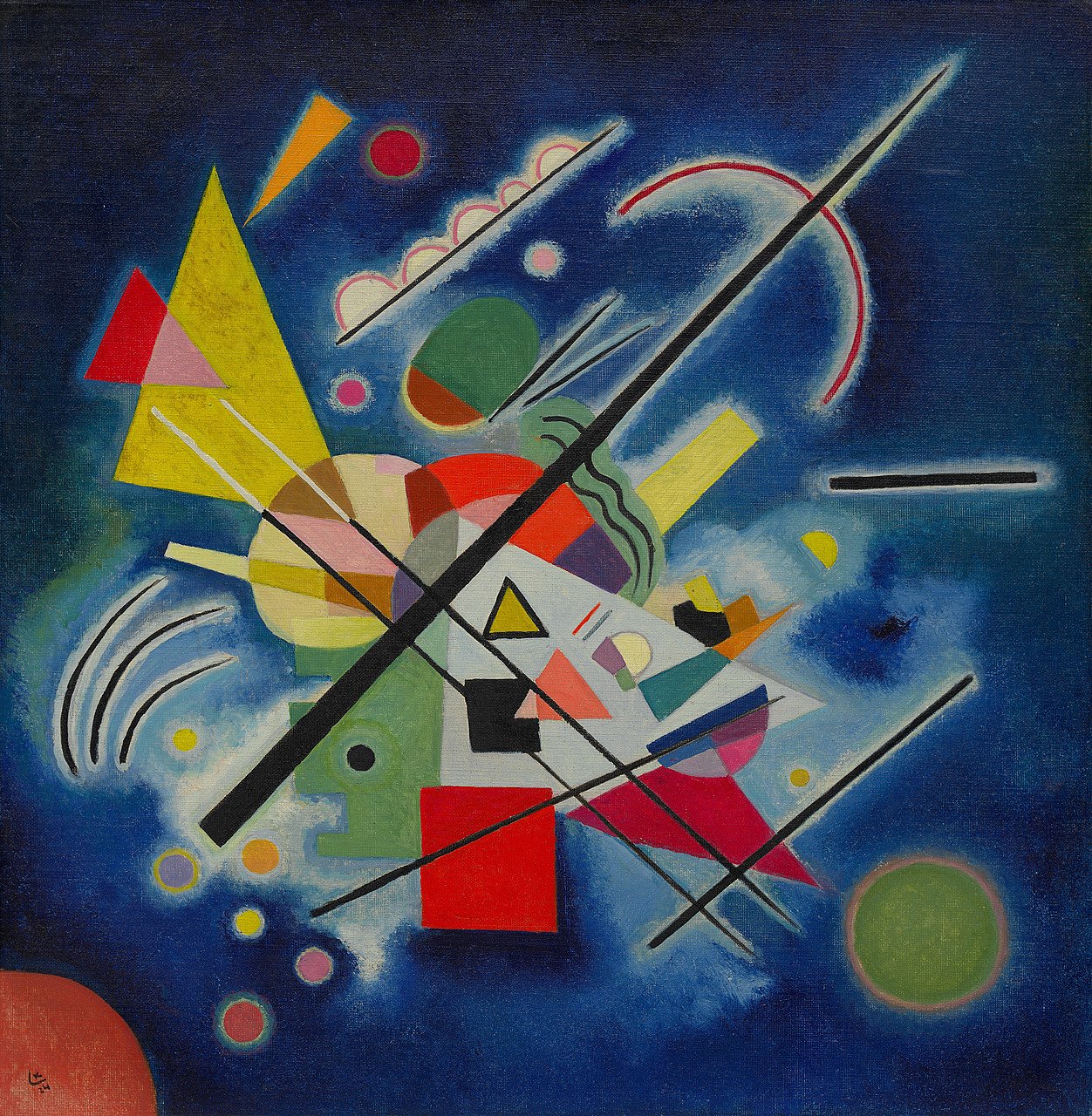
Vasily Kandinsky’s “Blue Painting (Blaues Bild)” also utilizes a cruciform composition. Kandinsky, known for his abstract works that often blend color, form, and line to create rhythmic and emotive pieces, employs intersecting lines in a subtle yet impactful way. His use of the cruciform structure in “Blue Painting” serves to organize the composition and guide the viewer’s eye, while also contributing to the overall balance and harmony of the piece.
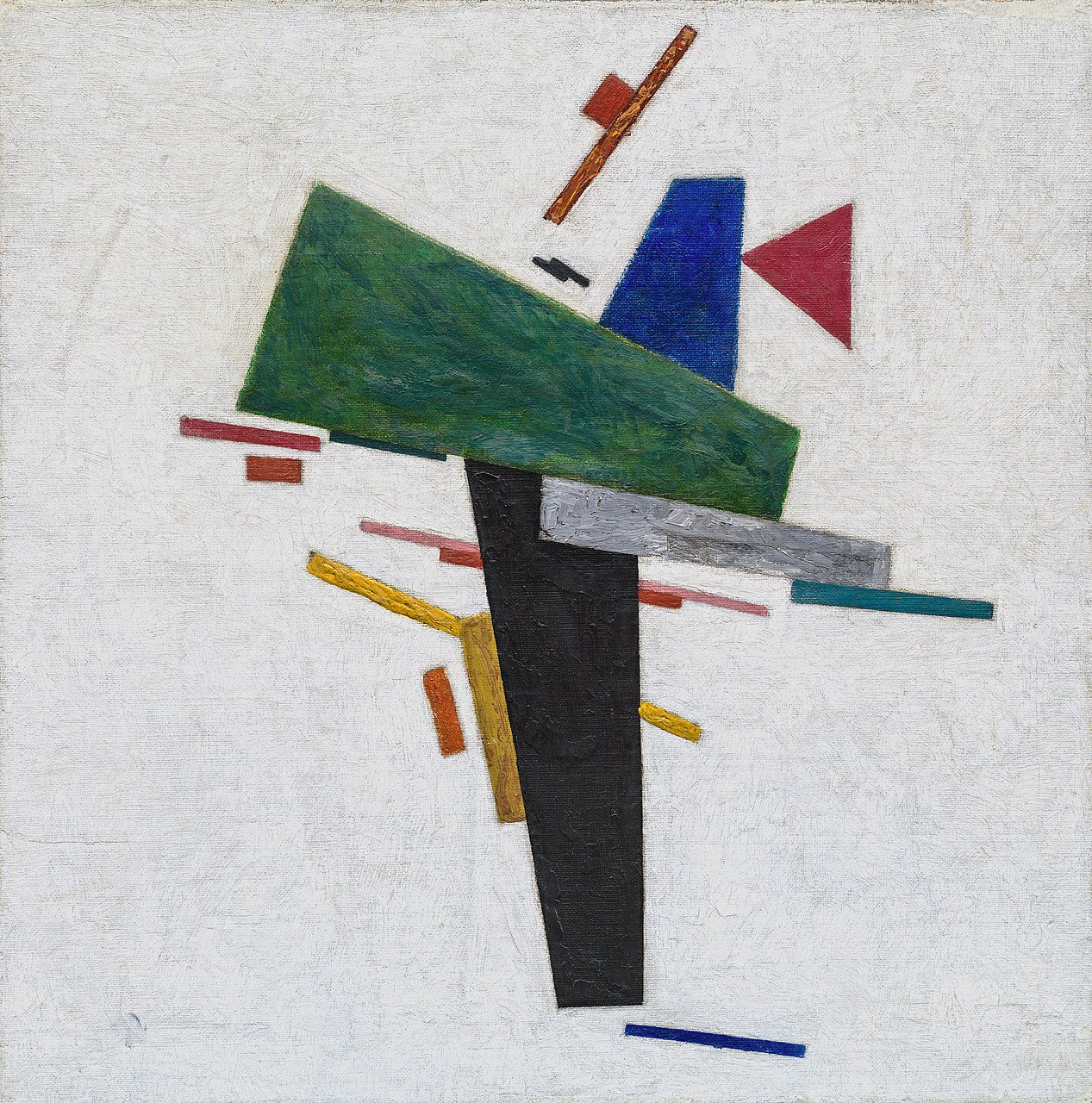
Kazimir Malevich’s “Untitled” presents a different approach to the cruciform composition. Malevich, famous for his Suprematist works, develops his compositions from straight lines and planes, creating contrasting areas of unmodeled color. In “Untitled,” the diagonal orientation of geometric forms and the overlapping of elements within a white ground create rhythms across the canvas. The cruciform in this context is more implied than explicit, as the rotational movement and spatial relationships of the forms suggest a dynamic interaction of lines and shapes.
In abstract art, asymmetrical, cantilevered, or unbalanced compositions play a crucial role in creating visual interest and conveying dynamic tension. These compositions are characterized by their departure from traditional symmetrical balance, instead opting for an arrangement of elements that challenges the viewer’s expectations and evokes a sense of movement and instability.
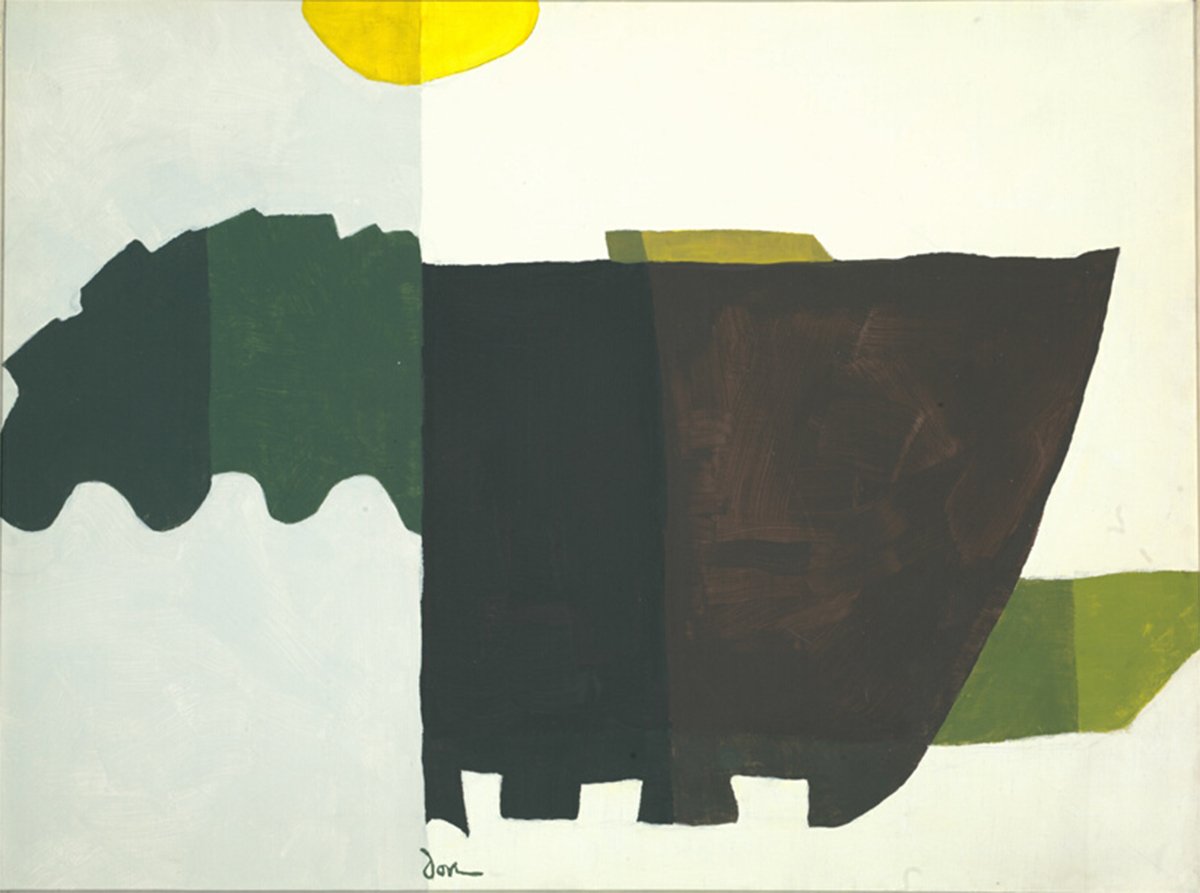
Arthur Dove’s “A Reasonable Facsimile” (1942) is a compelling example of a cantilevered composition. Although the painting appears nonobjective, it subtly suggests a landscape. The yellow half-circle at the top could be interpreted as the sun, a recurring subject in Dove’s work, while the green and brown areas may represent the earth below. This composition reflects Dove’s artistic endeavor to abstract the natural world, capturing its essence through a “reasonable facsimile” of its appearance. The asymmetry in the painting, achieved through the placement and interaction of these abstracted natural elements, creates a sense of balance within the imbalance, drawing the viewer’s eye through the composition and inviting contemplation.
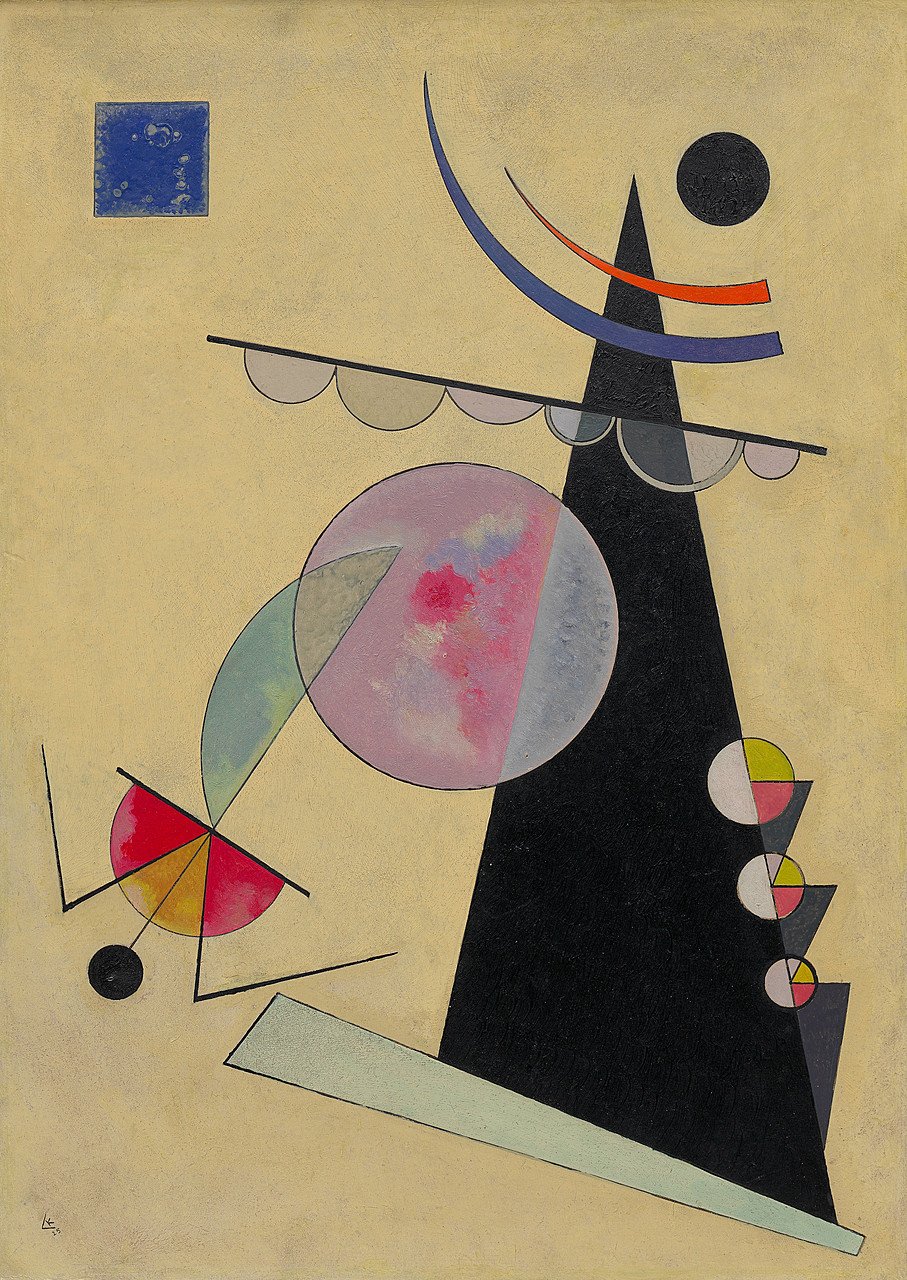
Vasily Kandinsky’s “Bright Unity (Helle Einheit)” is another example where an asymmetrical composition is used to great effect. The painting features a textured, muted yellow background with a contrasting small, blue square near the top left corner. A large, black, cone-like shape angled towards the bottom right, suggests movement or tipping, creating a sense of dynamic imbalance. This central figure supports various geometric shapes, including a large, semi-transparent circle with red and green hues, which adds depth and a focal point. White, semi-circular shapes appear to hang from a horizontal line, further enhancing the feeling of imbalance and tension. Additional elements, like a smaller black circle, a red and black triangular shape, and a long, thin, greenish bar, contribute to the composition’s cantilevered effect. The interplay of these shapes, lines, and colors creates a visual narrative that is both unbalanced and harmoniously composed, captivating the viewer’s attention.
In abstract art, horizontal compositions play a significant role in creating a sense of calm and balance. These compositions often utilize horizontal lines or bands that span the width of the canvas, evoking feelings of stability and tranquility. The positioning of these horizontal elements, whether high or low within the composition, can greatly affect the viewer’s perception and emotional response to the artwork.

Georgia O’Keeffe’s “Sky above Clouds IV” (1965) is a profound example of a high horizontal composition. Painted later in her life, this monumental work is the culmination of a series inspired by O’Keeffe’s experiences as an airplane passenger. The painting captures the vast expanses of clouds observed from airplane windows, transitioning from realistic depictions to more abstract images. The low placement of the cloud forms stretches across the canvas, creating a sense of endlessness and elevation. This high horizontal composition evokes a feeling of openness and serenity, drawing the viewer into the boundless sky.
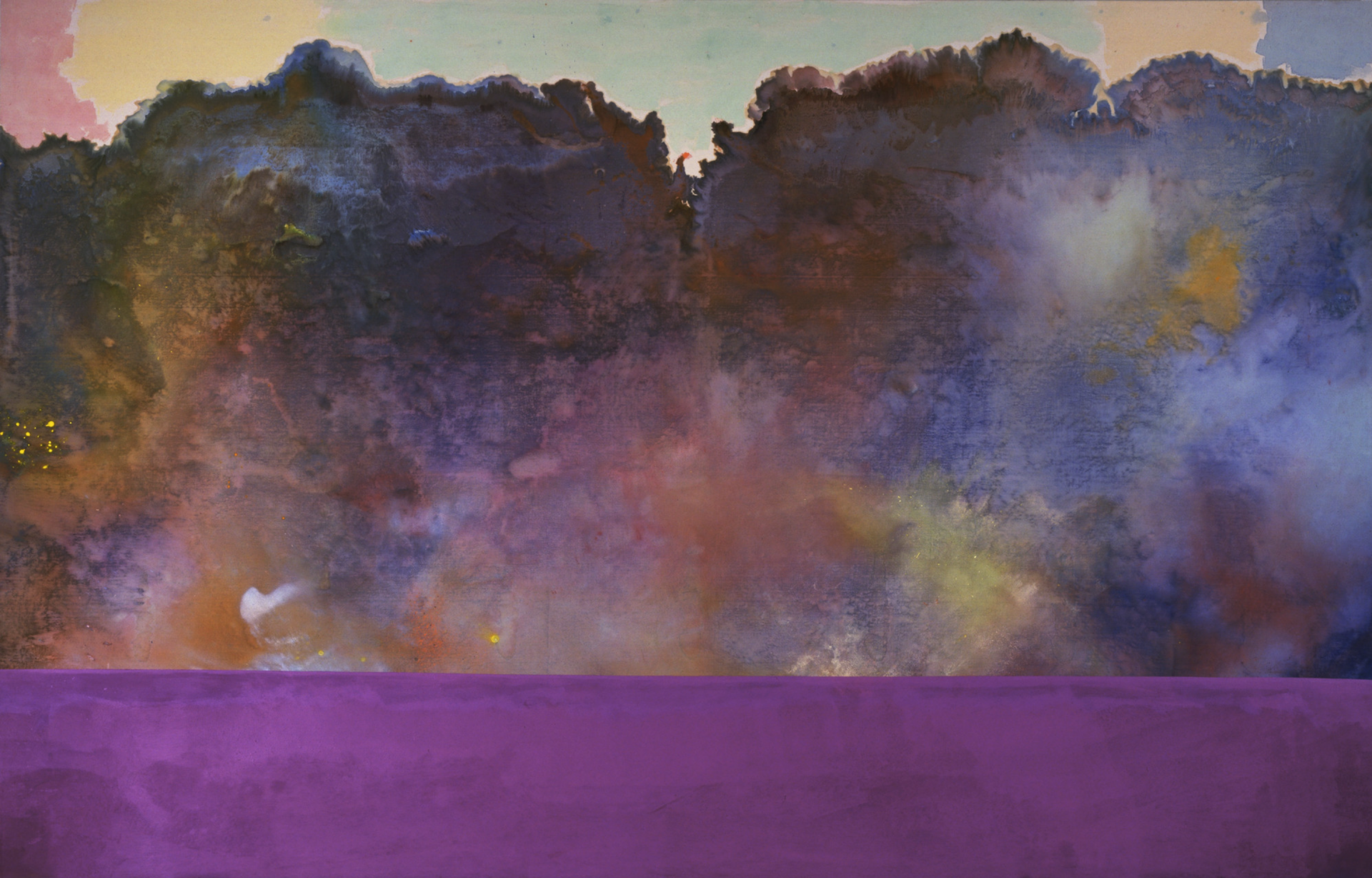
Ronnie Landfield’s “Diamond Lake” (1969) presents a different approach to horizontal composition. The upper section of the painting is a vibrant and expansive blend of colors, suggesting a dynamic and textured sky or abstract landscape. Hues of blue, purple, yellow, and red intermingle, creating a sense of depth and movement. The lower section, in contrast, features a solid, deep purple band that grounds the composition. This lower horizontal element provides a visual base, lending solidity to the ethereal colors above. The interplay between the fluid, organic shapes in the upper section and the structured color below creates a harmonious and contemplative piece. It plays with the concepts of horizon and landscape in abstract terms, balancing the tumultuous upper section with the calmness of the lower band.
Vertical composition in abstract art is a powerful tool for conveying concepts like growth, stability, and tension. This compositional style employs vertical lines or elements that draw the viewer’s eye upwards, often creating a sense of elevation, expansion, or confinement. Vertical compositions can symbolize various themes, from the natural growth of living things to the psychological sensation of being enclosed.
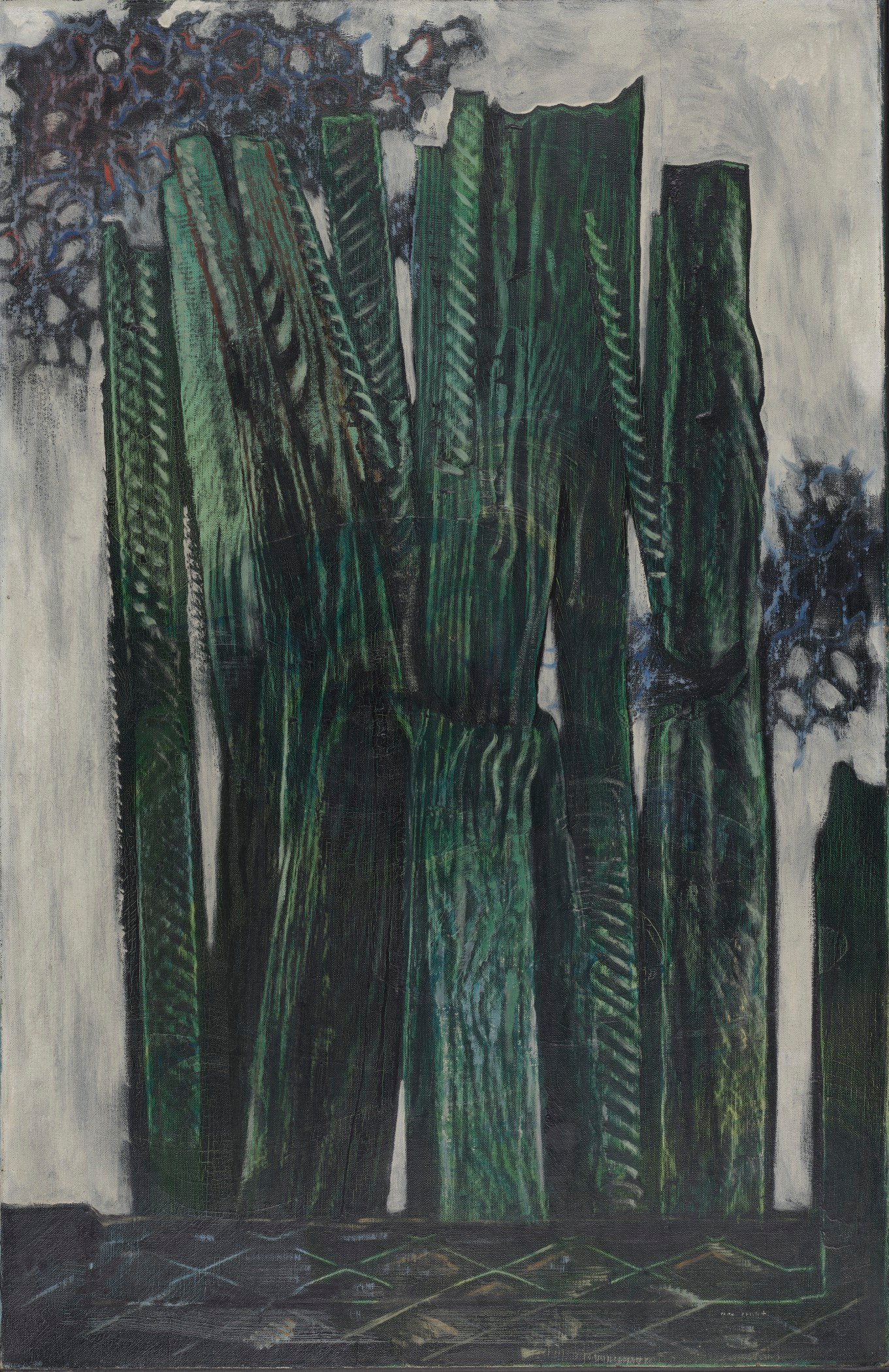
Max Ernst’s “Époque des forêts” (Age of Forests), painted in 1926, is an evocative example of vertical composition. In this painting, Ernst explores the mysterious and symbolic nature of woodland interiors. The work features a series of truncated, textured “trees” that rise vertically through a primordial landscape. This curtain of trees, with its imposing verticality, simultaneously evokes the feeling of breathing freely in an open space and the distress of being surrounded by hostile natural elements. The vertical composition here not only captures the essence of the forest but also reflects the psychological tension between freedom and confinement.
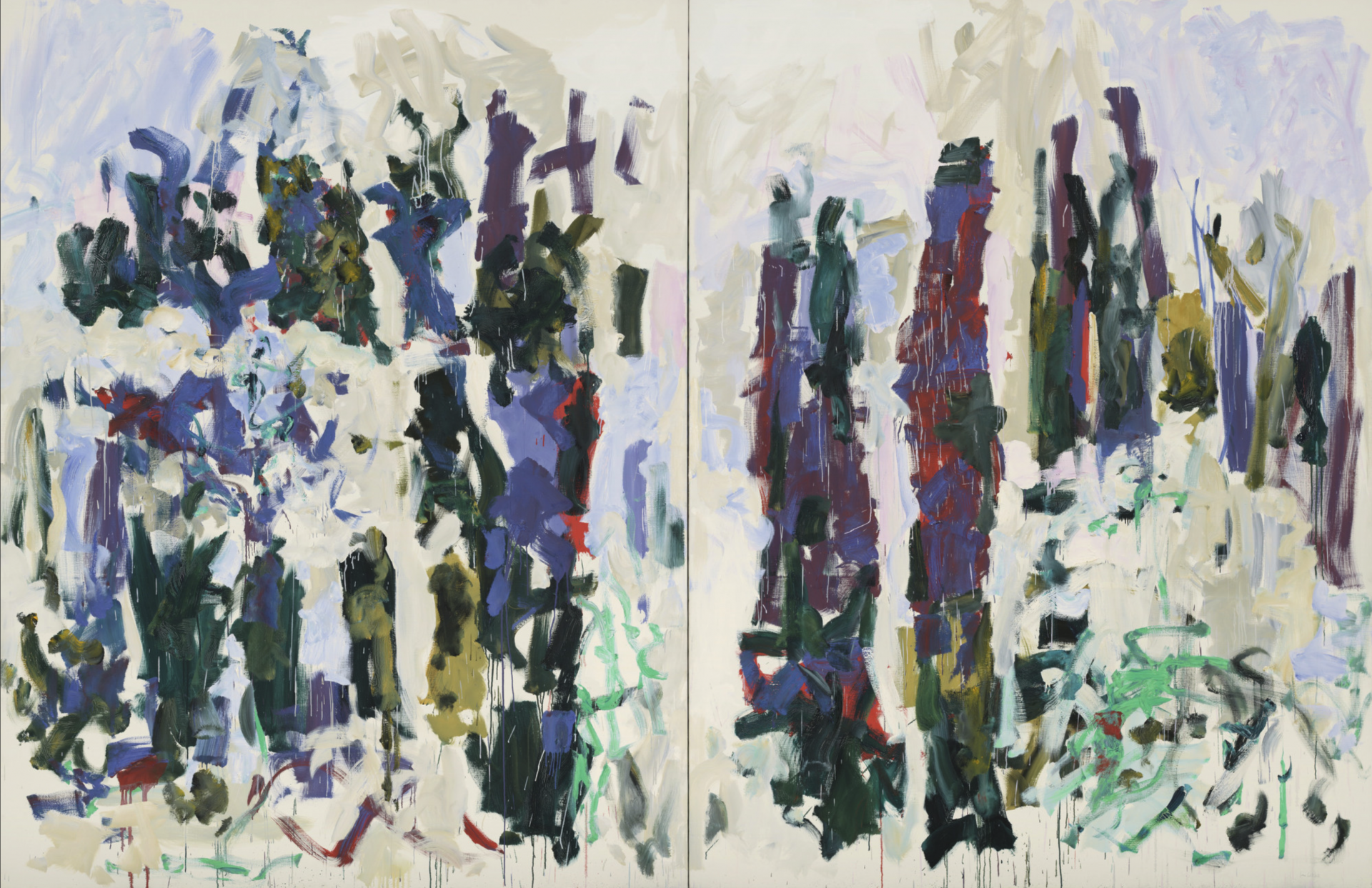
“Taillade” by Joan Mitchell, created in 1990, is another notable work that employs vertical composition. This diptych is characterized by vigorous vertical brushstrokes that suggest the upward growth of natural elements like trees and plants. The verticality in this painting symbolizes vitality and the inherent tendency of life to reach towards the light. Additionally, these vertical lines provide stability and structure amidst the chaotic array of colors and strokes, serving as a visual anchor within the composition. Mitchell’s use of bold colors, including deep blues, greens, and hints of red, enhances the dynamic and energetic nature of the painting, making it appear as a vibrant, living canvas.
The overlapping frames or frame-in-frame composition is a distinctive approach in abstract art that creates depth and narrative through layered structures. This technique involves the strategic placement of shapes and forms that intersect or are enclosed within each other, forming a visual narrative that goes beyond the surface layer. This method allows artists to explore spatial relationships and depth, leading viewers through a complex visual journey.
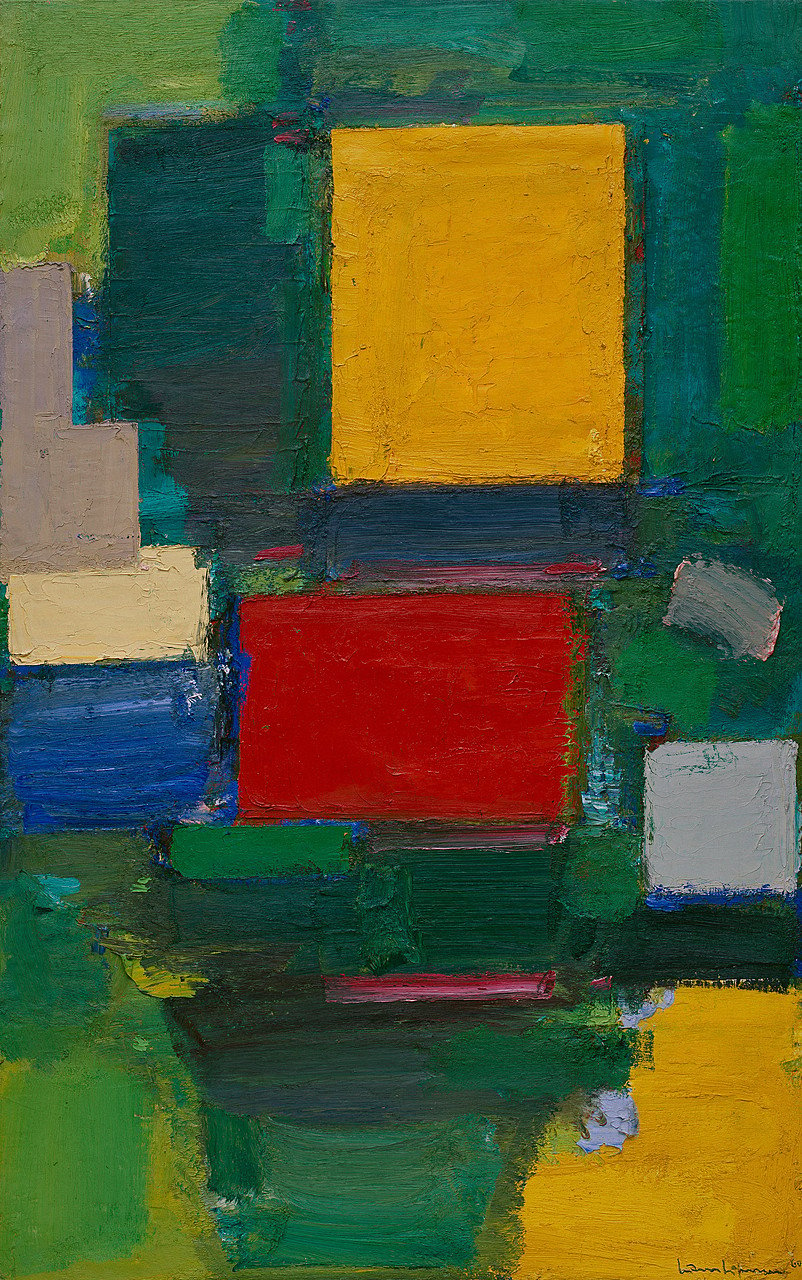
Hans Hofmann’s “The Gate,” painted between 1959-60, is a prime example of this composition style. Part of a series focusing on architectural volumes, Hofmann employs rectangles of color to emphasize the shape of the canvas, which remains consistent throughout his easel paintings. Although “The Gate” is devoid of a specific subject, Hofmann encouraged working from nature, even in abstraction. In this painting, the spatial relationship created by the floating color planes begins to take the form of a gate, as suggested by the title. The overlapping layers and interaction of colors form a complex spatial arrangement, inviting the viewer to explore the depth and perceive the gate-like structure.
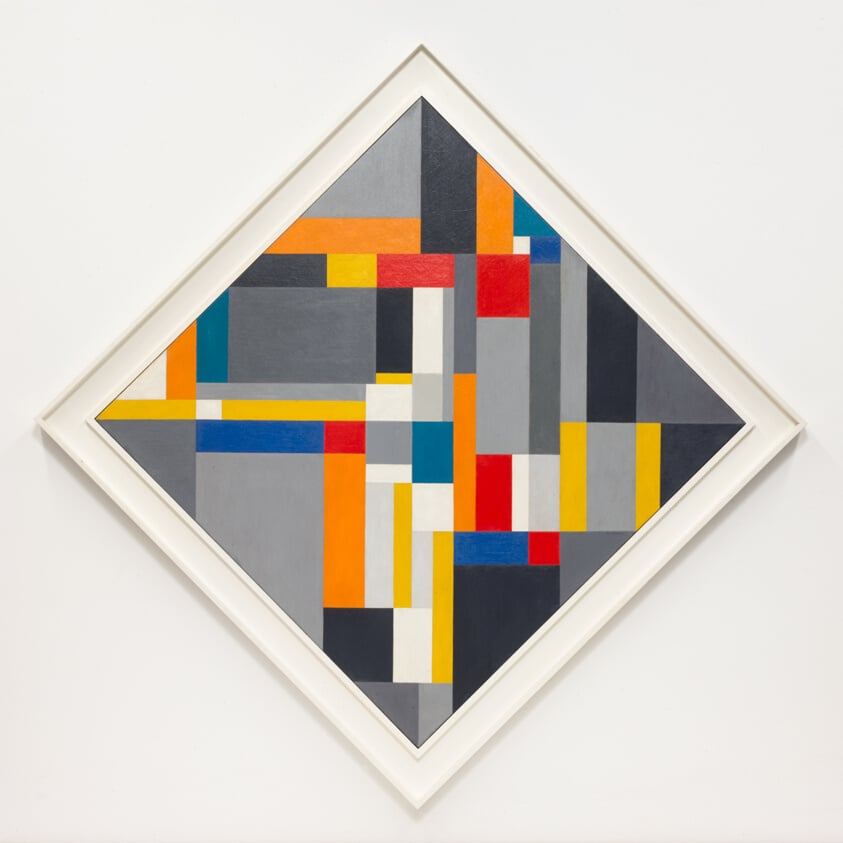
Ilya Bolotowsky’s “Grey Diamond” (1955) is another example that utilizes an overlapping frames composition. Set within a diamond-shaped boundary, this geometric abstraction focuses the viewer’s attention on the internal interplay of shapes and colors. Rectangles and squares in shades of grey, blue, yellow, orange, red, and white intersect and overlap within the diamond, creating spatial depth and complexity. This layering suggests a narrative where each element contributes to the overall composition while maintaining its individual identity.
The curves or curvilinear composition in abstract art harnesses the expressive power of fluid, organic forms. This approach departs from the rigidity of straight lines and angles, offering a softer, more naturalistic interpretation of shapes that can evoke growth, continuity, and life. Curves introduce movement, grace, and a sense of infinity, making them a powerful tool for abstract artists to convey a range of emotional and conceptual themes.
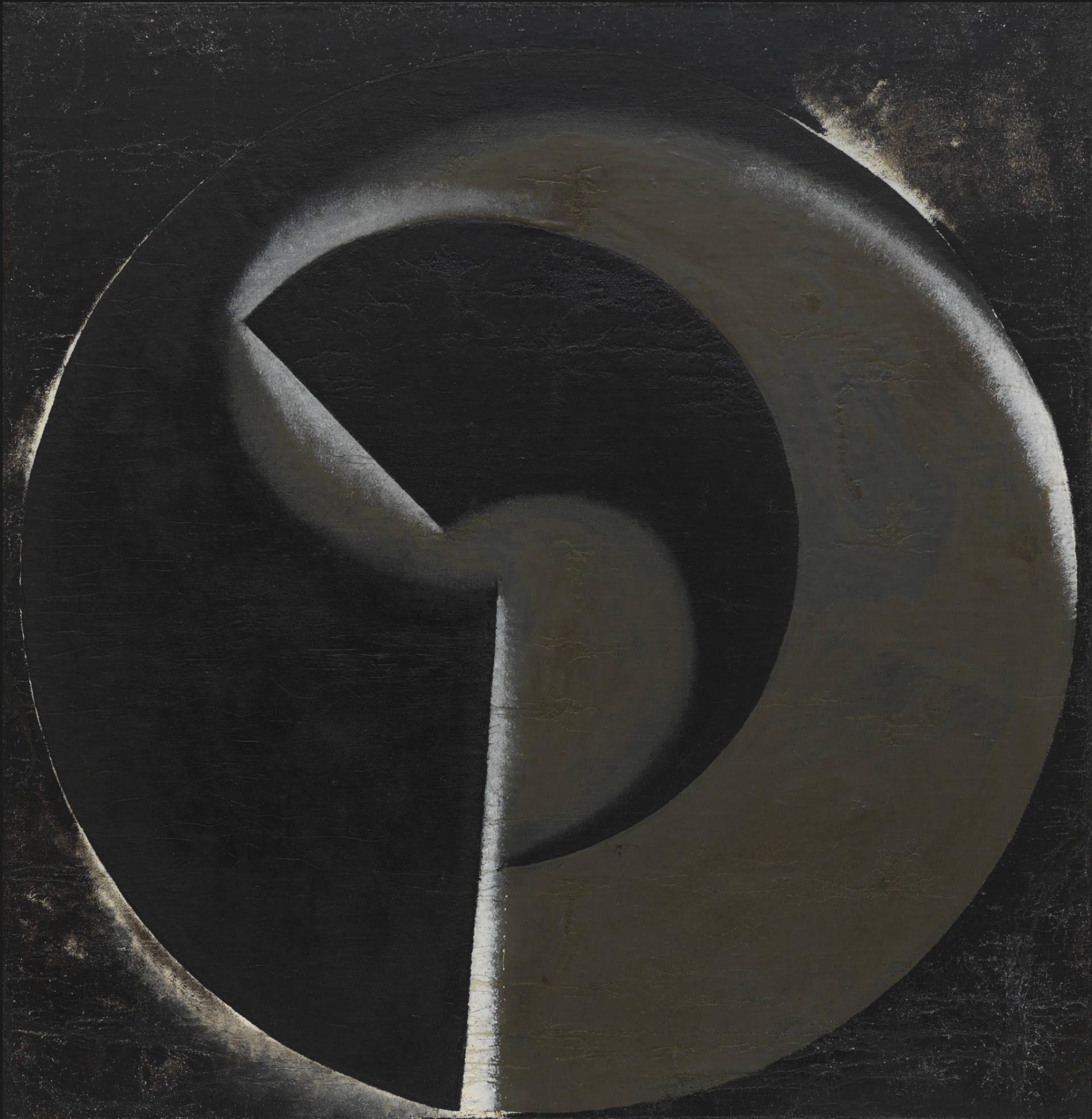
Aleksandr Rodchenko’s “Non-Objective Painting no. 80 (Black on Black)” is a striking example of a curvilinear composition. Dominating the canvas is a large, segmented circle, rendered in black and deep, metallic gold. The variation in black tones creates depth and texture, while the gold segments offer reflective contrast, drawing the viewer’s eye. The curves in this composition suggest infinity and wholeness, themes often explored in abstract art. Rodchenko’s limited color palette further emphasizes the form, allowing the interplay of light and shadow to highlight the curvilinear shapes and the subtle intricacies of the composition.
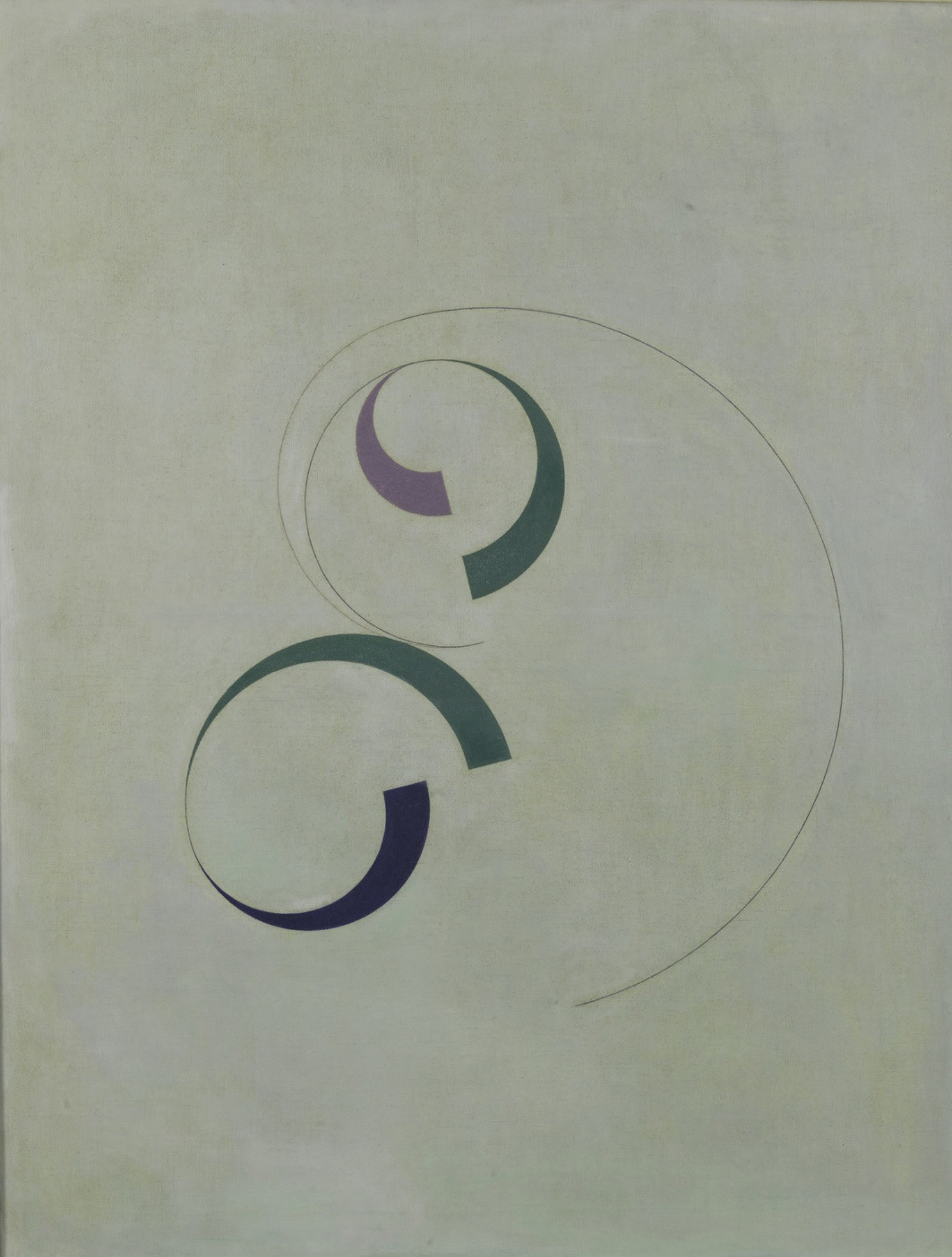
Ivan Serpa’s “Untitled” (1954) is another work that effectively uses curves to convey the expressiveness of simple forms. This painting features intertwining curves and circular segments in dark green and purple against a light green background. The elegant interaction of these curvilinear forms with the negative space creates a visual dialogue that is both harmonious and complex. In abstract art, curves are associated with fluidity and natural forms. Serpa’s use of these shapes introduces softness and continuity, offering a contrast to the often geometric and rigid structures in abstract compositions. The simplicity of the lines speaks to a minimalist aesthetic, while the arrangement provides complexity, inviting viewers to explore the depth and rhythm within the painting. The variations in color and line weight add dynamism, suggesting movement and harmony, and reflecting Serpa’s exploration of form and abstraction.
The constellation or group mass composition in abstract art refers to an arrangement where multiple elements are grouped together to form a cohesive whole. This technique creates a focal point or distributes weight across the canvas, often resulting in a dynamic and complex visual experience. Through the careful placement and interaction of these elements, artists can explore themes of connection, space, and the relationship between individual parts and the collective.
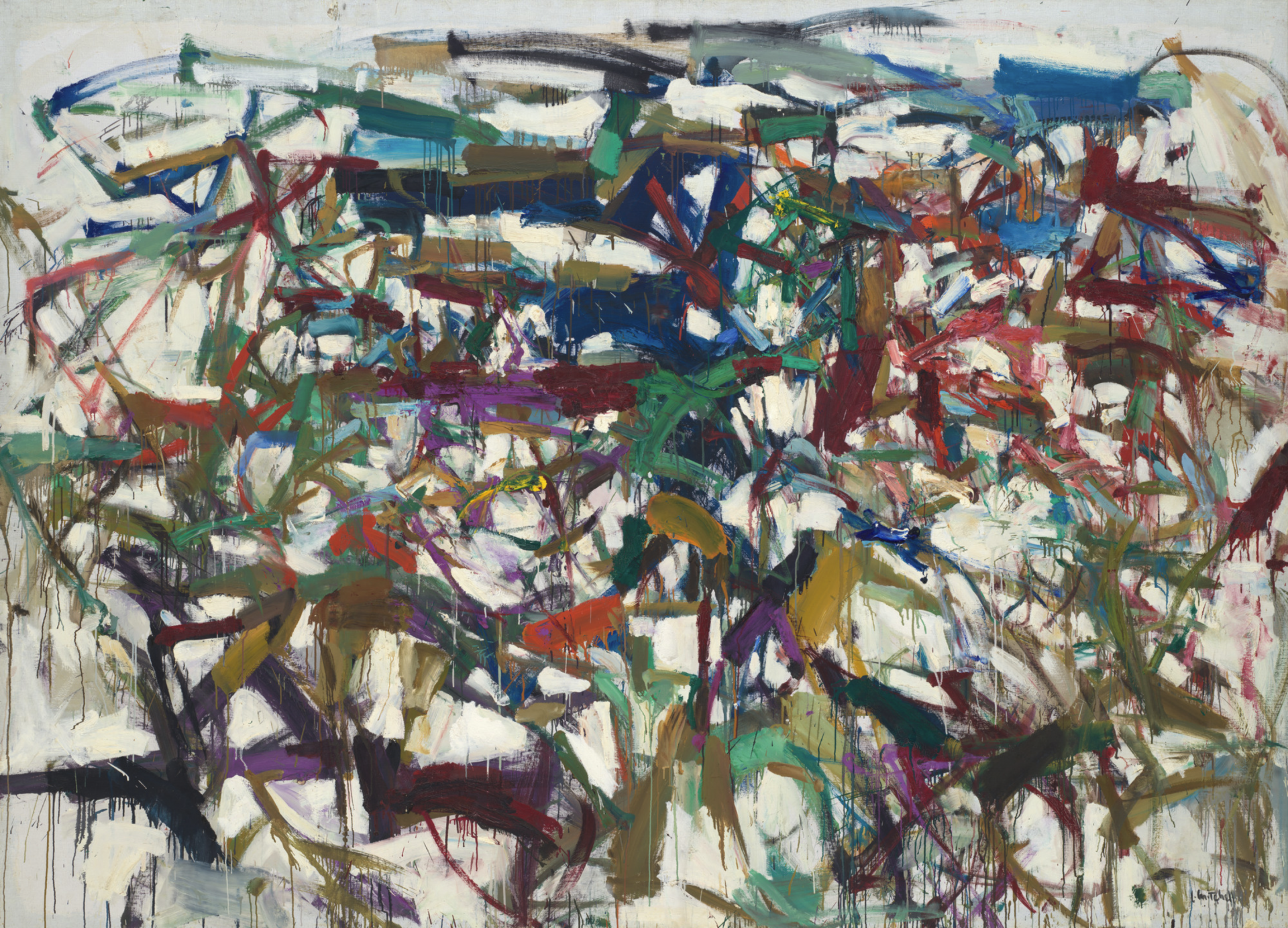
Joan Mitchell’s “Ladybug” (1957) is a remarkable illustration of a group mass composition. In this painting, an accumulation of brushstrokes—arcs and dashes in marigold, mauve, dark berry, and brown—appear to leap off the canvas. The colors overlap, and mix, creating a chromatic web that seems to hover over layers of white paint. Mitchell’s approach is characterized by control within the apparent spontaneity, as she meticulously applies each color with attention to their relationships and the weight of each brushstroke. Unlike many of her Abstract Expressionist contemporaries, Mitchell prefers a balance of figure and ground, even in a fully abstract image. “Ladybug” exemplifies this, with its dense paint merging with liquid drips and flatness with relief, creating a focal point amidst the surrounding space.
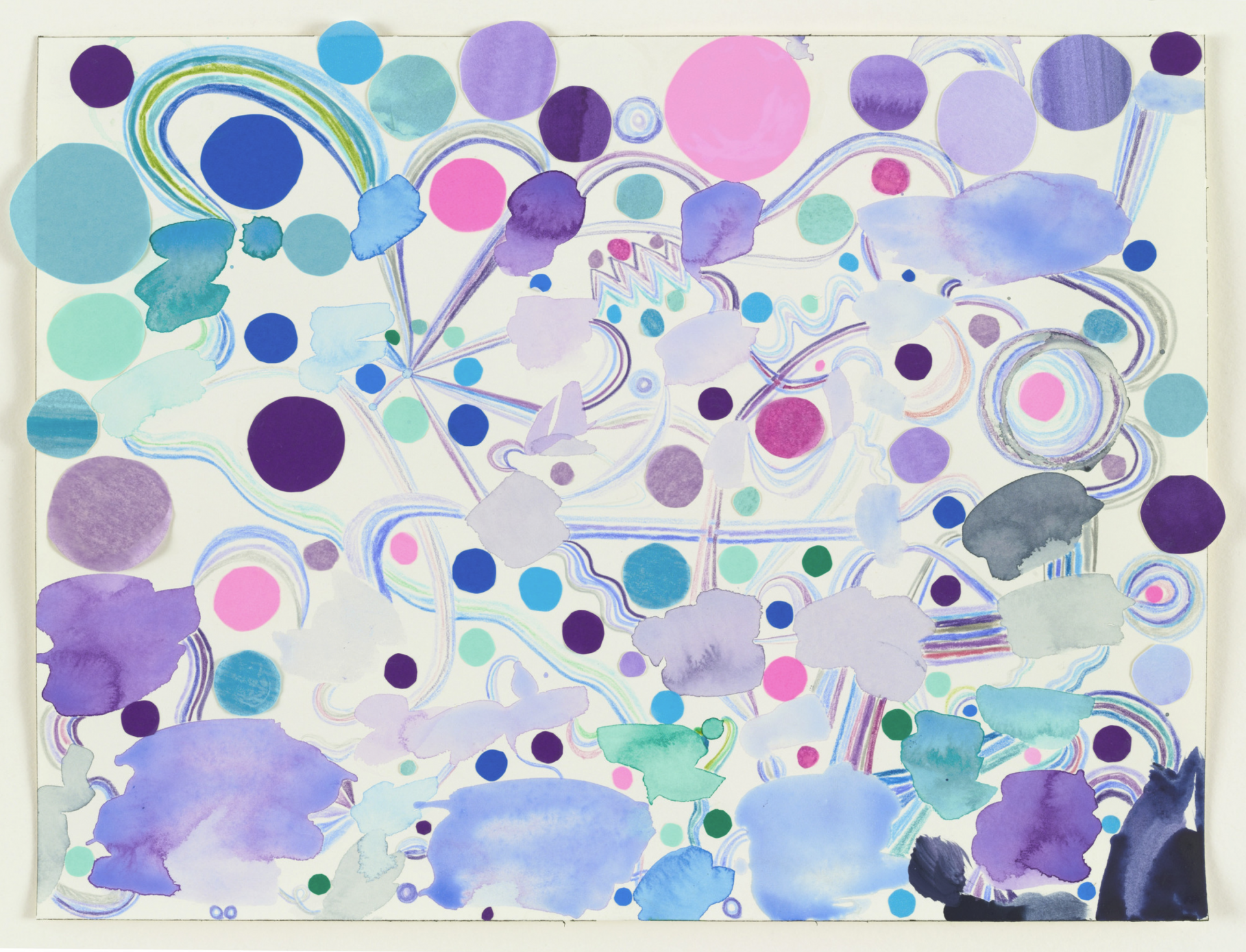
Laura Owens’s “Untitled” (2003) also employs a constellation composition, but in a distinctly different style. This vibrant abstract painting features an arrangement of shapes and forms that float across the canvas, reminiscent of celestial bodies or elements in an ecosystem. Circles, swirls, and cloud-like forms in blues, purples, and pinks, along with brighter accents, are distributed in an organized chaos. Each shape interacts with the others, forming a harmonious collective. This constellation composition is characterized by the scattered yet connected parts, inviting the viewer to explore the relationships between these elements. Owens’s use of overlapping forms and varying transparencies adds depth and layers of meaning, creating a narrative within the interconnected shapes.
The meandering or ‘H’ composition in abstract art is a style that creates a visual journey through the use of interconnected lines and forms. This type of composition often involves the strategic placement of elements that guide the viewer’s eye across the canvas, exploring the dynamic interplay of space, form, and line. In the case of the ‘H’ composition, the arrangement of elements can resemble the structure of the letter ‘H’, either literally or through a more abstract interpretation.
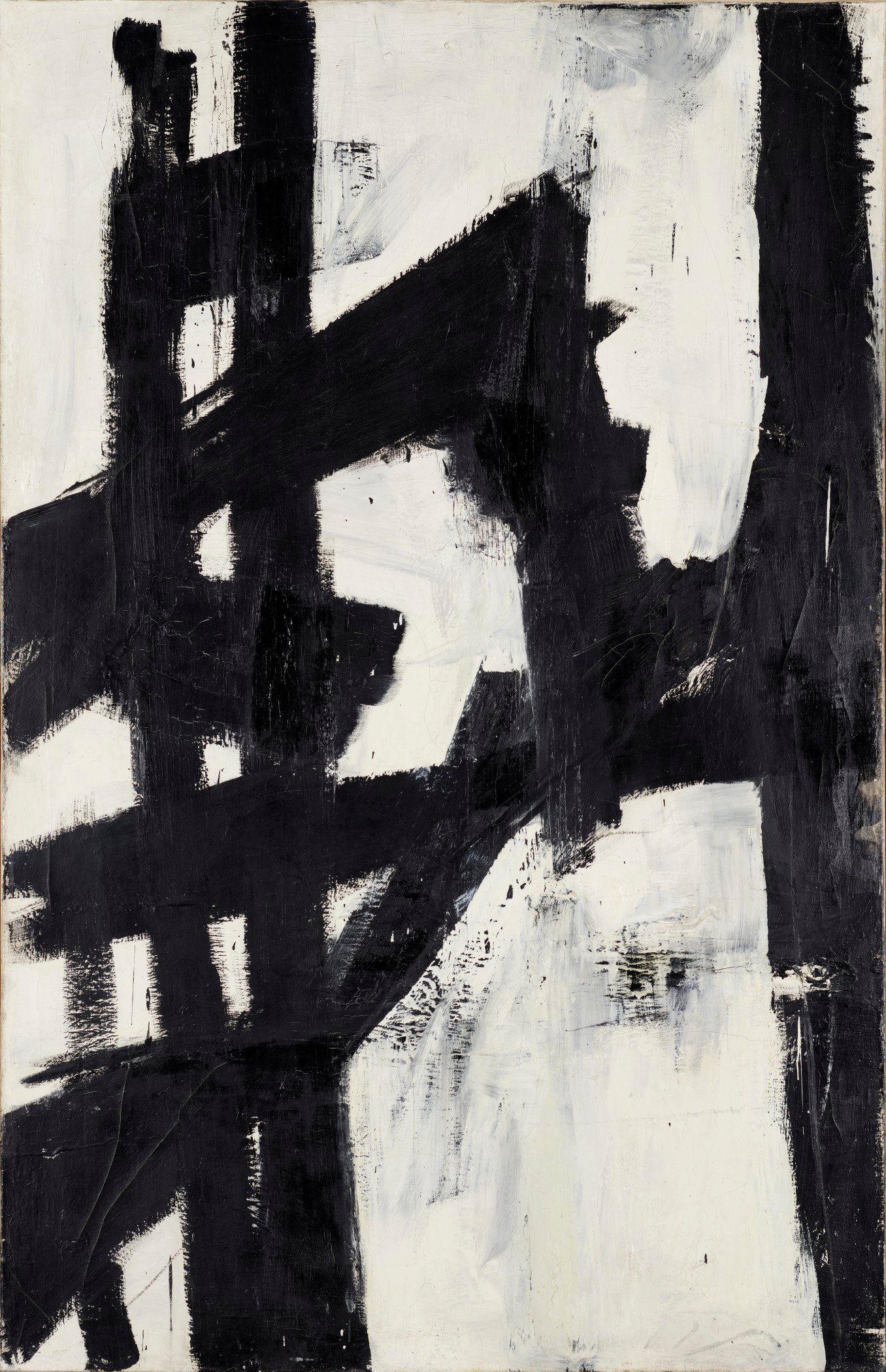
“New York, N.Y., 1953” by Franz Kline is an abstract expressionist painting that showcases the meandering or ‘H’ composition. Dominated by bold, black brushstrokes against a white background, the painting features a series of sweeping, gestural lines that intersect and form a network reminiscent of the letter ‘H’. The contrast between the black and white emphasizes the dramatic strokes, creating a visual rhythm that draws the viewer’s gaze. Kline’s painting captures the energy and complexity of the urban landscape, with the erratic movement of the lines serving as a metaphor for the bustling streets and towering structures of New York City. The open forms and interplay of positive and negative space encourage viewers to engage with the abstract shapes, allowing for personal interpretations and narratives.
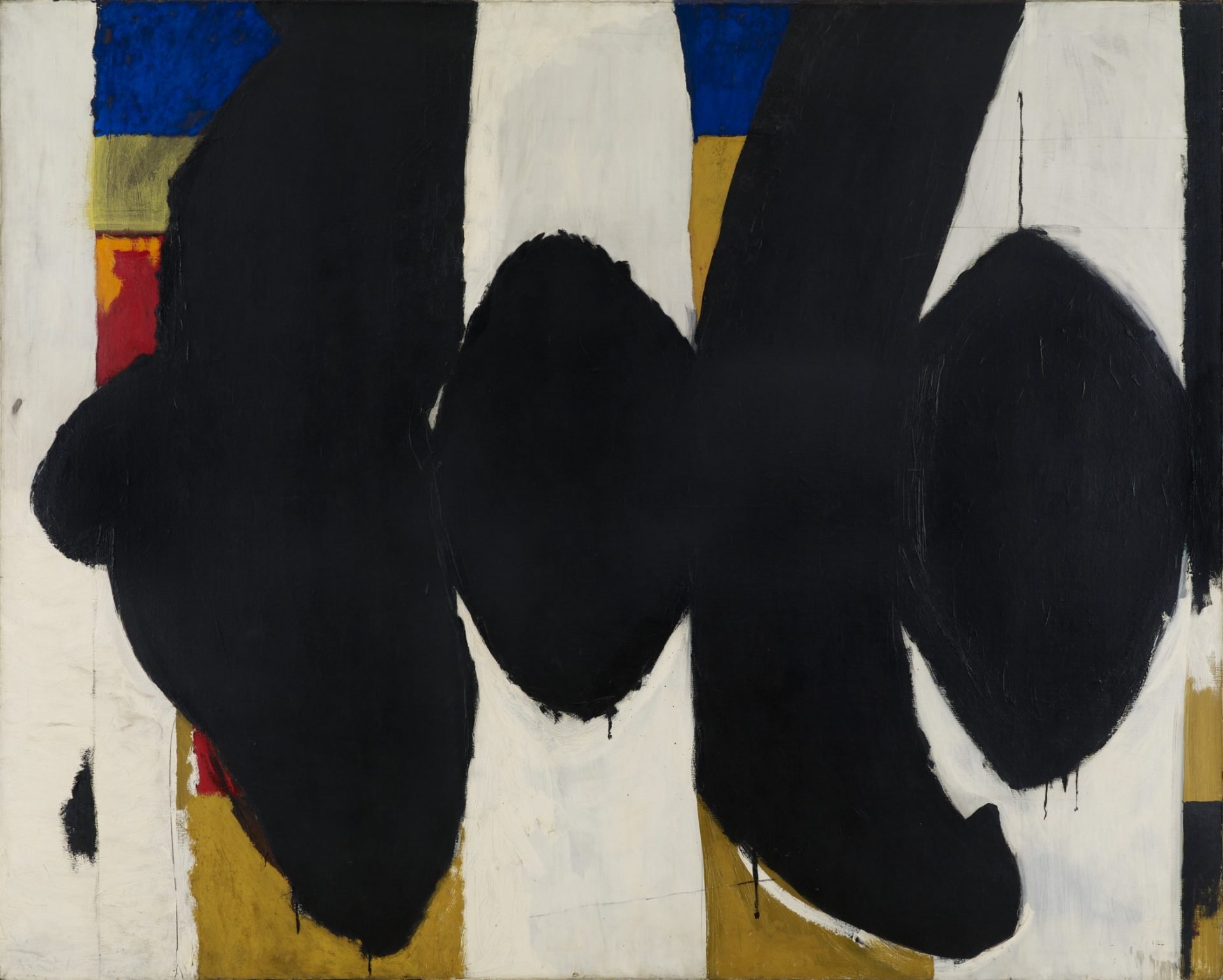
“Elegy to the Spanish Republic XXXIV” (1953-1954) by Robert Motherwell, part of his “Elegies” series, is another example of a meandering or ‘H’ composition. The painting features large, black, amorphous shapes set against a background with blocks of white, yellow, red, and blue. These bold forms create a visual pathway, guiding the viewer’s eye and contributing to the sense of depth and movement. The ‘H’ composition is interpreted through the arrangement of shapes and the vertical white space between them, which forms lines resembling the sides of an ‘H’, while the black forms act as the connecting crossbar. The painting’s thematic engagement with the Spanish Civil War is reflected in the contrast of the black forms against the lighter background, evoking a sense of mourning and solemnity.
Diagonal composition in abstract art is a powerful tool for creating a sense of dynamism and movement. By using diagonal lines and forms, artists can convey action, tension, and directional flow within their works. This compositional style is particularly effective in suggesting instability and change, contrasting with the stability often associated with horizontal and vertical lines.
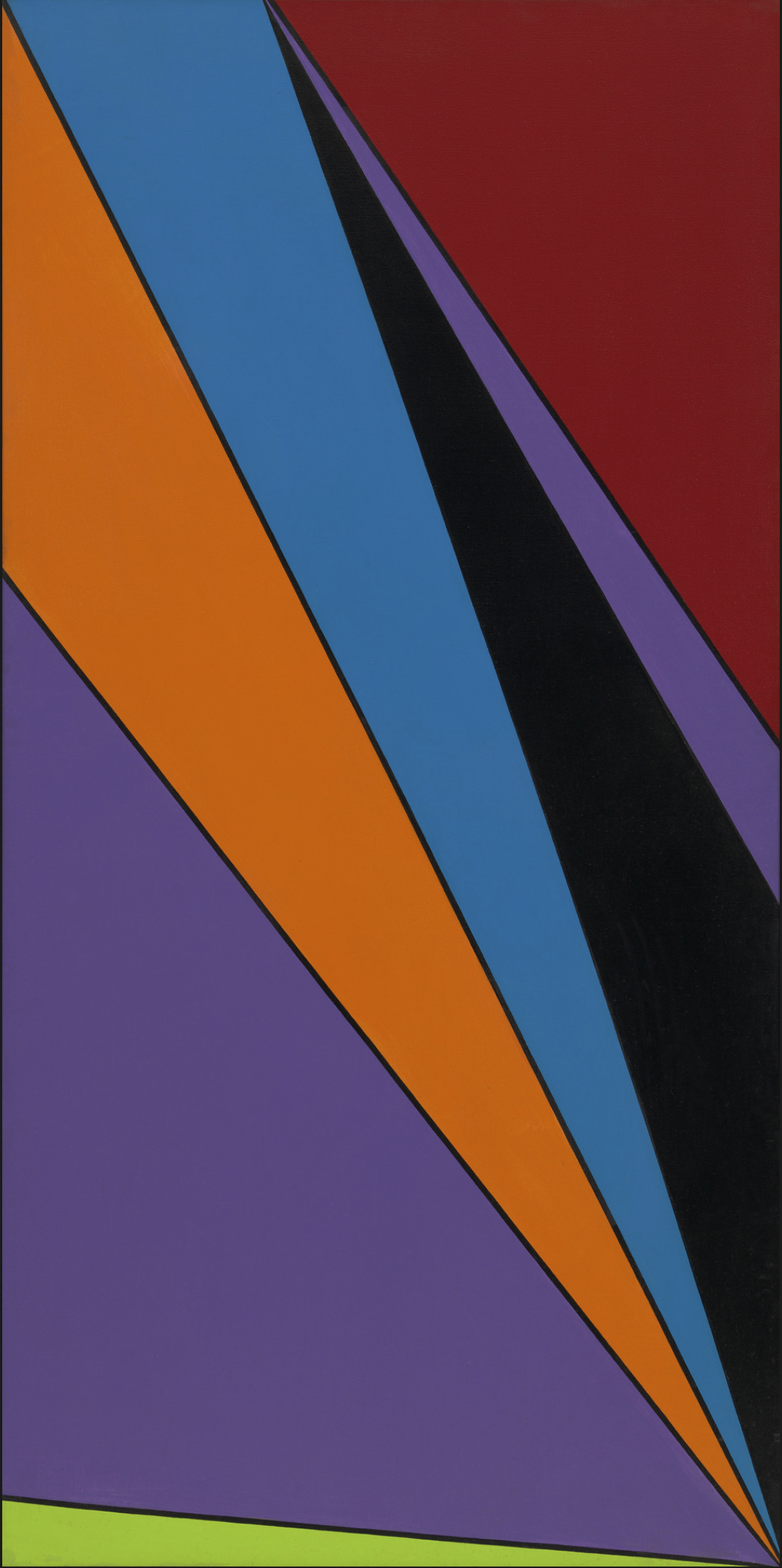
“Agriaki” by Olle Baertling, created in 1959, exemplifies the use of diagonal composition in abstract art. The painting is characterized by sharply defined geometric shapes that converge at various angles, resulting in a dynamic and energetic composition. Dominated by diagonals, these lines create both tension and harmony, directing the viewer’s eye across the canvas. The bold color palette, featuring red, blue, orange, purple, and a hint of green against areas of black, further accentuates the painting’s diagonal lines. These lines serve as visual pathways, leading in and out of the picture plane and suggesting a space that extends beyond the canvas. Baertling’s modernist interest in depicting movement and energy is evident in “Agriaki,” where the angular forms represent the forces of change and the dynamic nature of the modern world.
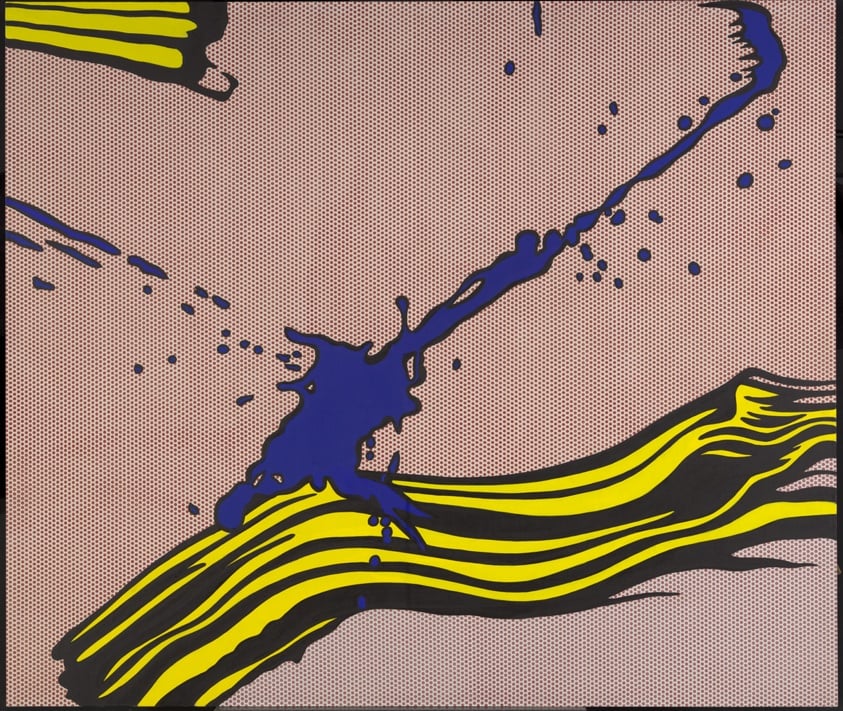
“Brushstroke with Spatter” by Roy Lichtenstein, painted in 1966, is another striking example of diagonal composition. The work features a bold, enlarged depiction of a brushstroke in yellow with black outlines, diagonally slashing across the canvas. This is accompanied by a vibrant blue spatter that extends the motion of the stroke, creating a sense of action and dynamism. The background, composed of Lichtenstein’s signature Ben-Day dots in a tan hue, contrasts with the vivid colors of the brushstroke and spatter, enhancing the visual impact. The diagonal arrangement not only directs the viewer’s eye but also conveys the force and directionality of the artist’s hand movement. Lichtenstein’s work often explores the intersection of high art and mass media, and “Brushstroke with Spatter” is a commentary on the act of painting, the art world, and popular culture, showcasing his iconic approach to composition.
The Golden Section or Golden Ratio is a mathematical ratio that has been used in art and architecture for centuries to create aesthetically pleasing compositions. This ratio, approximately 1:1.618, is often found in nature and is believed to contribute to a sense of balance and harmony in visual designs. In abstract art, the Golden Ratio can be applied to guide the placement of elements within a composition, creating a natural sense of equilibrium and focus.
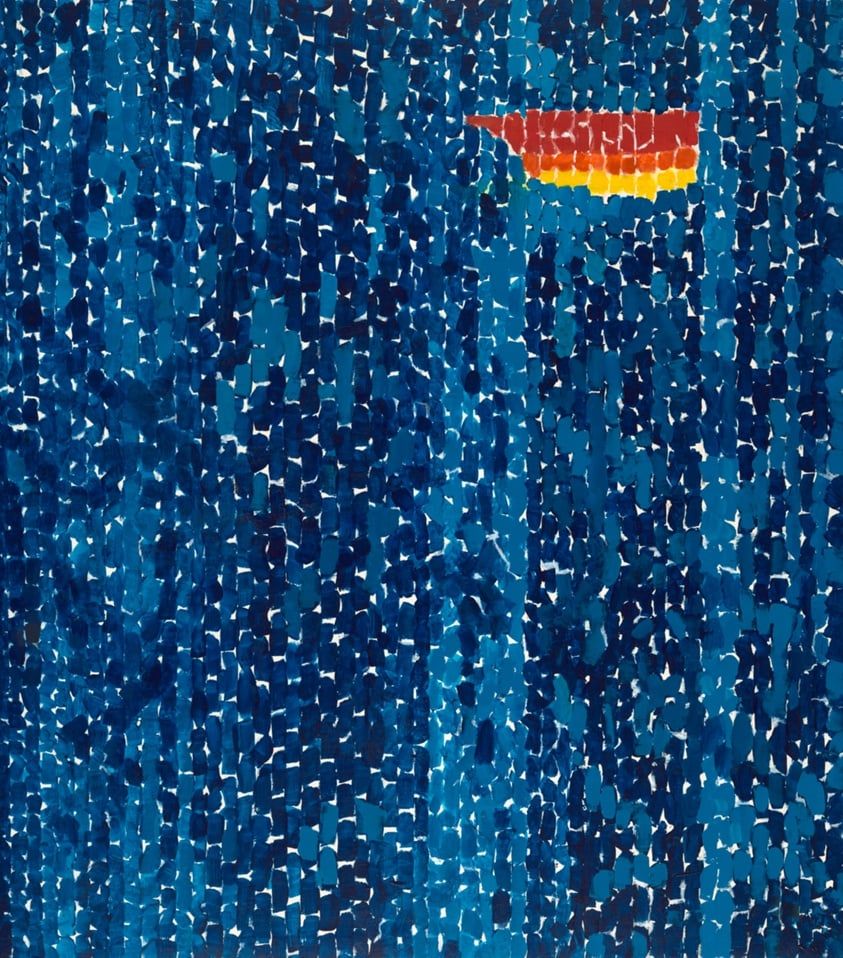
“Starry Night and the Astronauts” by Alma Thomas, created in 1972, is an abstract work that may subtly employ the principles of the Golden Section. Thomas uses a mosaic of short, expressive brushstrokes in shades of blue to depict a star-filled night sky. A small rectangular area of warm colors—orange, red, and yellow—provides a focal point against the expansive blue background. This warm-toned area could be positioned in alignment with the Golden Ratio, creating a visual balance and drawing the viewer’s eye. Thomas’s combination of random brushstrokes with a structured composition suggests a harmonious and balanced work, where the contrast between the cool and warm colors might represent the human presence in the vast universe.
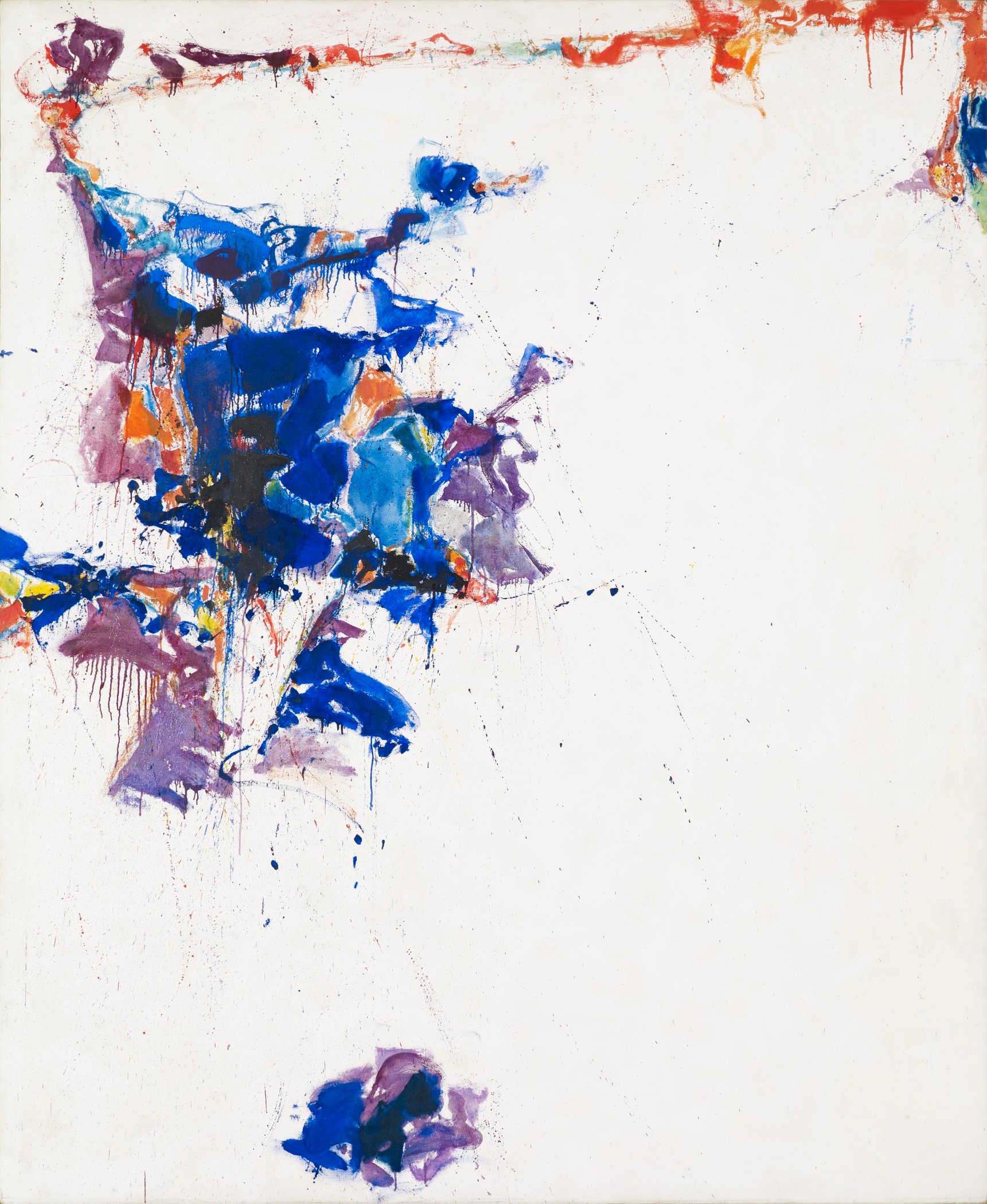
“The Whiteness of the Whale” by Sam Francis, painted in 1957, is another abstract expressionist painting that subtly incorporates the Golden Ratio. Dominated by white, the painting features a central burst of color—blues, reds, and purples—that creates movement within the calm white space. The placement of this color cluster and the overall distribution of visual weight might intuitively align with the Golden Section, establishing a focal point and a sense of natural harmony. Francis’s use of negative space and the interplay between color and the white background reflect his interest in spontaneity and the emotive power of color and form. The title and the visual emptiness evoke the vastness of the sea, with the Golden Ratio providing an underlying structure to the composition’s apparent randomness.
In abstract art, the concept of tension in composition plays a crucial role in engaging the viewer and creating a dynamic visual experience. Tension can arise from various elements within a painting, such as the juxtaposition of colors, the interplay of shapes, or the relationship between positive and negative space. This tension captivates the viewer’s attention and evokes emotional responses, making the artwork more impactful and thought-provoking.
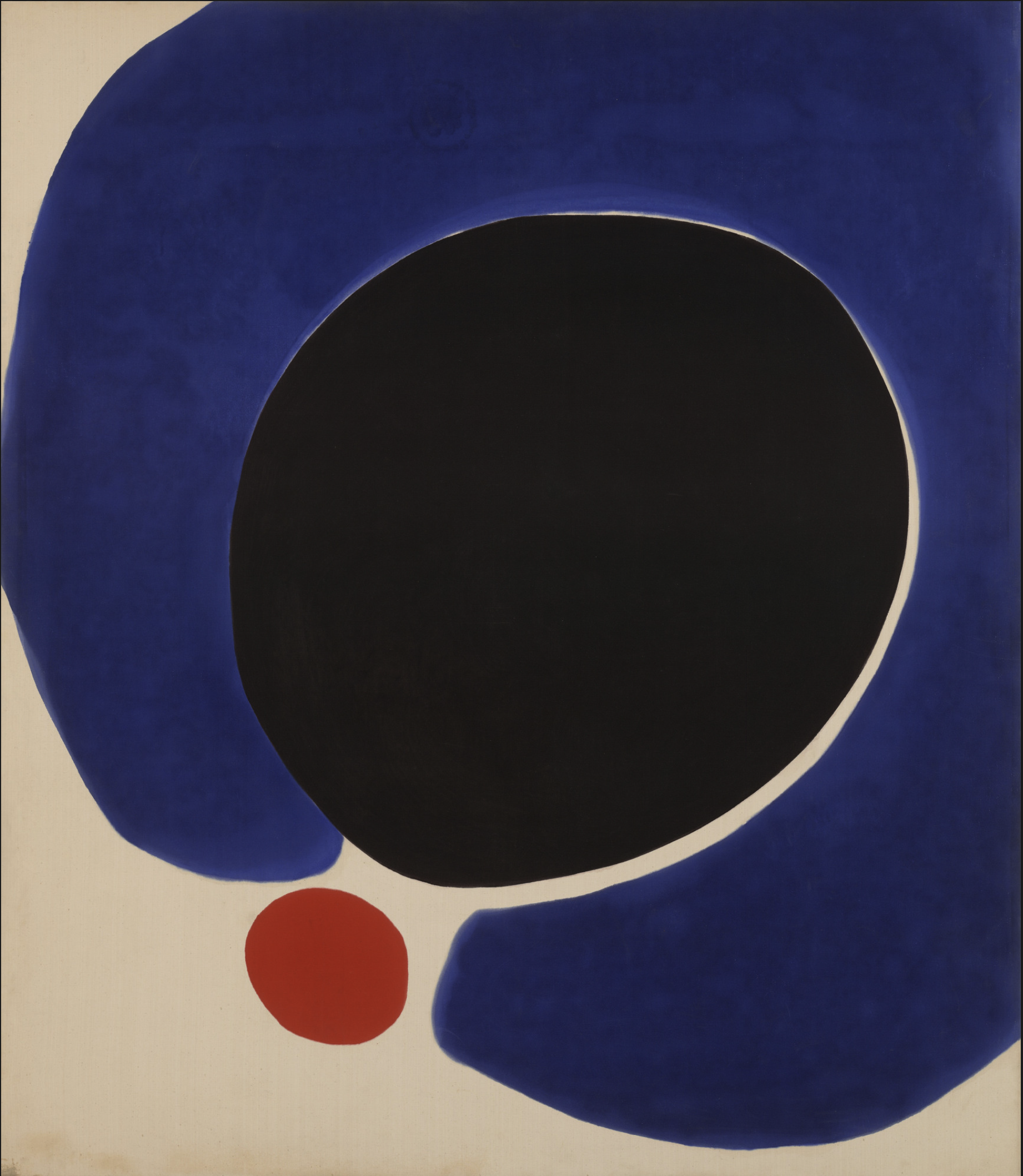
“Cleopatra Flesh” by Jules Olitski, created in 1962, exemplifies the use of tension in abstract composition. Dominated by a large, deep blue shape encircling a central black circle, the painting evokes a sense of envelopment and sensuality. This primary arrangement is offset by a contrasting small red circle towards the bottom, creating a visual counterpoint and enhancing the compositional tension. The background’s pale, flesh-toned hue not only contrasts with the striking blue and red but also emphasizes the spatial relationships. The interplay between the colors and shapes, along with the use of negative space, generates a dynamic tension, inviting viewers to engage with the emotional complexity and harmony within the painting. Olitski’s work, through its exploration of color field painting, demonstrates how abstract art can create a compelling visual experience without representational imagery.
Centered compositions in abstract art are often used to achieve a sense of balance and harmony within the artwork. By focusing the visual weight and focal point in the center of the canvas, artists can create a feeling of equilibrium and stability. This compositional approach draws the viewer’s eye to the middle of the painting, where the interplay of forms and colors becomes the central feature.
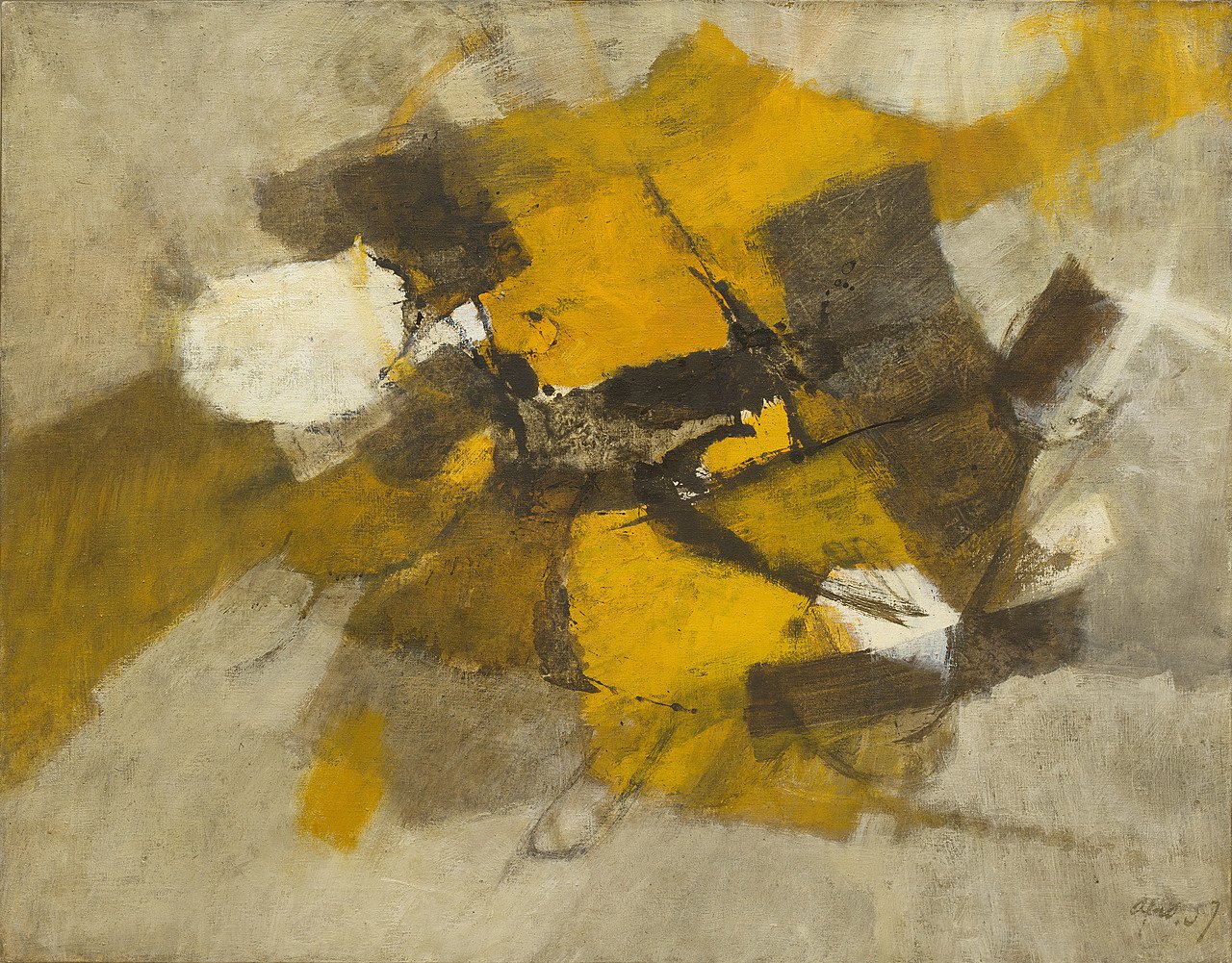
“Night Flight (Volo di notte)” by Afro, painted in 1957, is a great example of a centered composition in abstract art. The painting features bold yellow forms set against a textured grey background, with black lines and white highlights adding depth and movement to the central cluster. This arrangement leads the viewer’s eye directly to the heart of the canvas, where the colors and shapes converge and interact. The central positioning of these elements suggests a moment of convergence or an epicenter of activity, potentially representing the concept of ‘flight’ as indicated in the title.
Radiant or radiating compositions in abstract art use lines and forms that emanate from a central point, creating a sense of energy and focus. This compositional style often suggests movement and expansion, drawing the viewer’s eye towards the center and then outward along the radiating elements. It can be used to convey a range of themes, from the idea of a dynamic universe to the concept of cyclicality and motion.
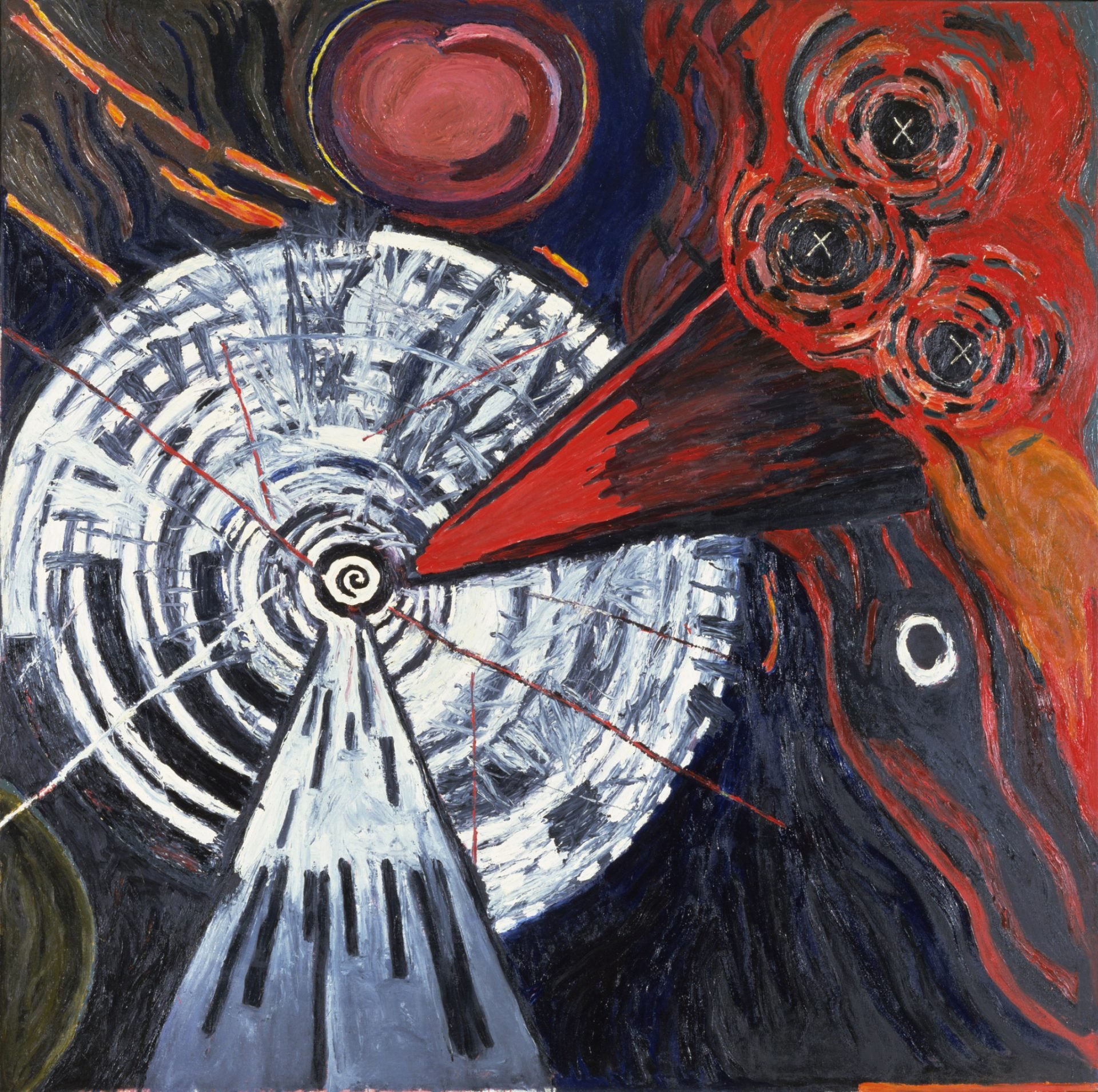
“I am an American… Uneasy Dreams” by Katherine Porter, painted in 1981, is an abstract painting that exemplifies a radiant composition. Centered around a spiral motif, the painting features lines and shapes that extend outward, giving the impression of movement and expansion. The composition contrasts vivid red and black forms on one side with a white and grey spiral on the other. Red lines intersect the two halves, focusing attention on the center. Above, two circular forms— one solid red and the other composed of smaller circles—appear to orbit the spiral. This arrangement suggests a powerful energy emanating from the core, as if it were a source of light or force propelling the other elements. The title of the painting invites contemplation on identity, culture, and the subconscious, with the radiating forms representing the various influences shaping our experiences.
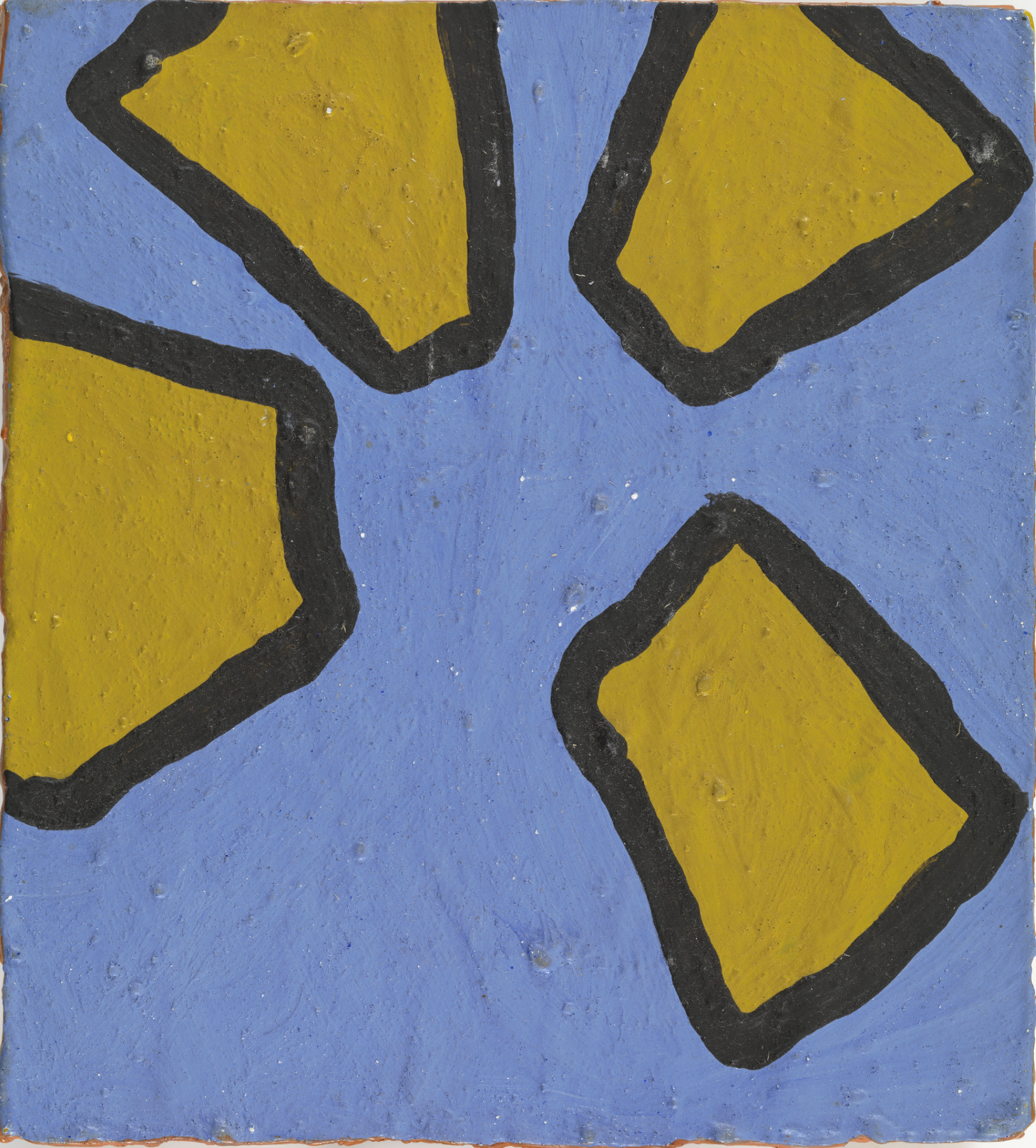
“Yellow Wheel with Orange Border” by Lawrence Weiner, created in 1963, is another abstract work utilizing a radiant composition. It features yellow geometric shapes, reminiscent of wheel segments, outlined in black against a blue background. These shapes radiate from a central point, creating a wheel-like form with a sense of outward movement. The bold colors and defined edges of the shapes enhance the visual impact, with the blue background emphasizing the yellow, and the black outlines providing contrast. An orange border frames the composition, drawing attention inward to the central pattern. The painting can be interpreted as a representation of energy or motion, with the wheel suggesting rotation and the segments pointing outward, symbolizing dispersion or expansion. Weiner’s piece explores the effects of radiating patterns and how they convey dynamism and structured movement within a static medium.
Balanced composition in abstract art refers to the harmonious arrangement of forms, colors, and textures that creates visual equilibrium. This balance can be achieved through symmetry, repetition, or the strategic distribution of visual weight across the canvas. It plays a crucial role in engaging the viewer and guiding their eye through the artwork, often resulting in a composition that feels stable and aesthetically pleasing.
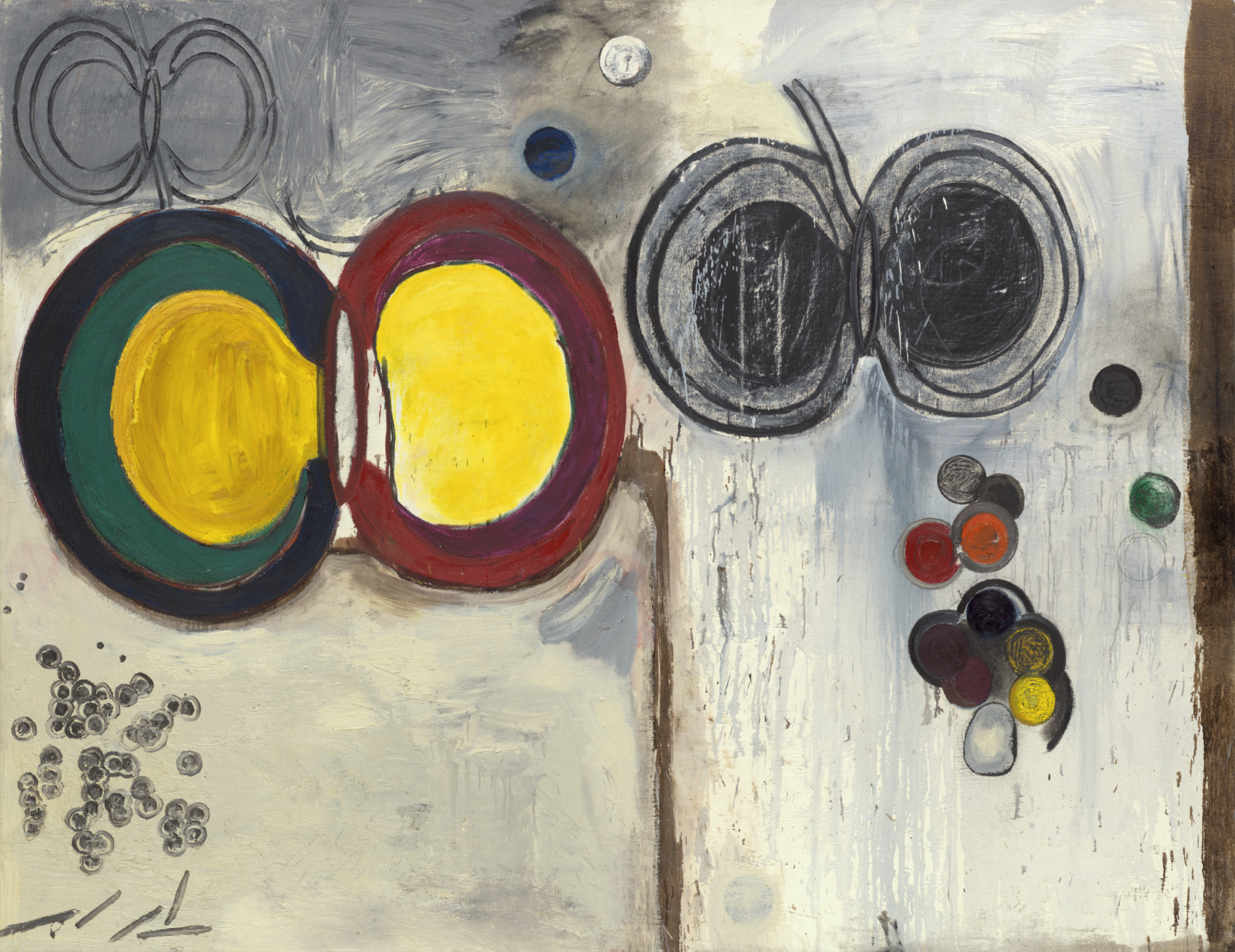
“Conjugation” by Terry Winters, painted in 1986, exemplifies a balanced composition in abstract art. The painting features circular and spherical shapes set against a neutral, textured background divided into lighter and darker areas. On the left, two large circles—one dark green with a yellow center, and the other red with a yellow center—are connected by a line, suggesting a connection. This pair of circles is echoed on the right side by two large black circles, complemented by a vertical array of smaller, colorful circles. The symmetry and repetition of these forms, along with the thoughtful distribution of color, achieve a sense of balance. The contrasting backgrounds on either side of the canvas enhance the vibrancy of the circles, creating equilibrium while adding visual interest.
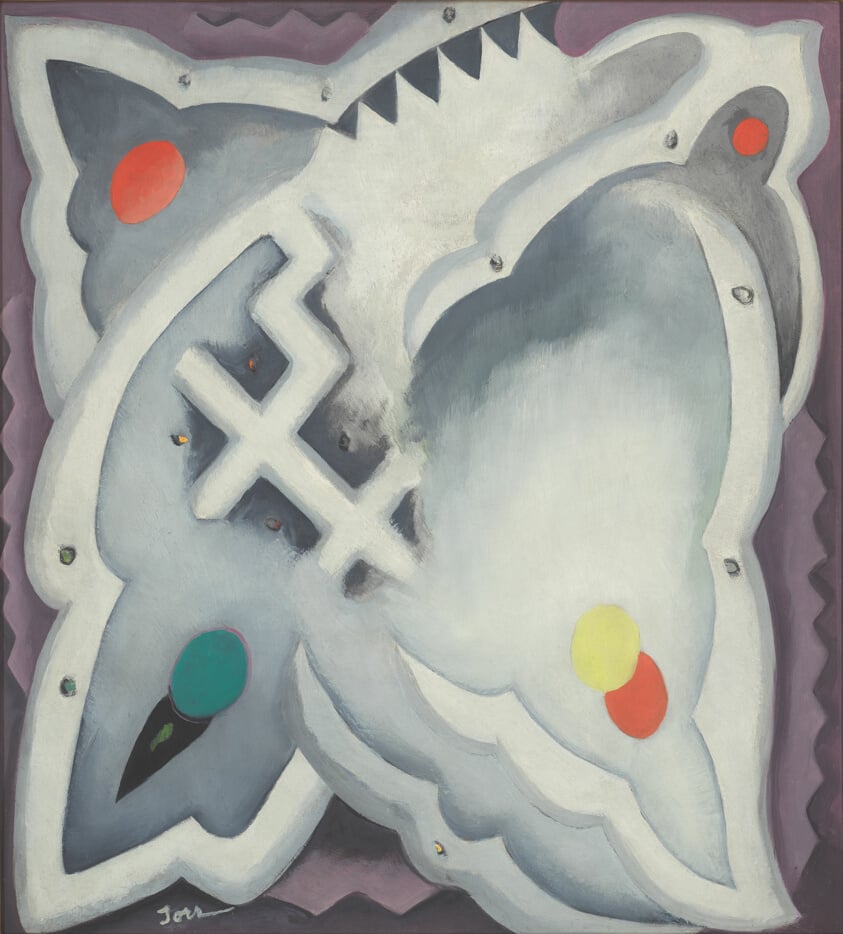
“Extemporaneous” by Helen Torr, painted in 1927, also demonstrates balanced composition through a careful arrangement of forms and colors. The painting presents organic and geometric shapes against a muted background, with a large, curvilinear form in the center resembling a stylized profile or abstract figure. This form is surrounded by jagged edges and intersected by a dark pattern, with small, brightly colored circles adding focal points and rhythm. The balance in “Extemporaneous” is achieved through the interplay of color and form rather than symmetry. The neutral tones of the central shape are offset by surrounding colors and the accents of primary hues, creating a dynamic equilibrium. The combination of curving and angular lines, varied textures, and colors results in a harmonious composition that reflects Torr’s modernist approach to conveying emotion and movement within a static image.
The 3-spot or triangular composition in abstract art is a design principle that relies on the placement of three key elements in a triangular arrangement. This compositional style offers both stability and dynamism, guiding the viewer’s eye through the artwork and creating a sense of coherence and balance.
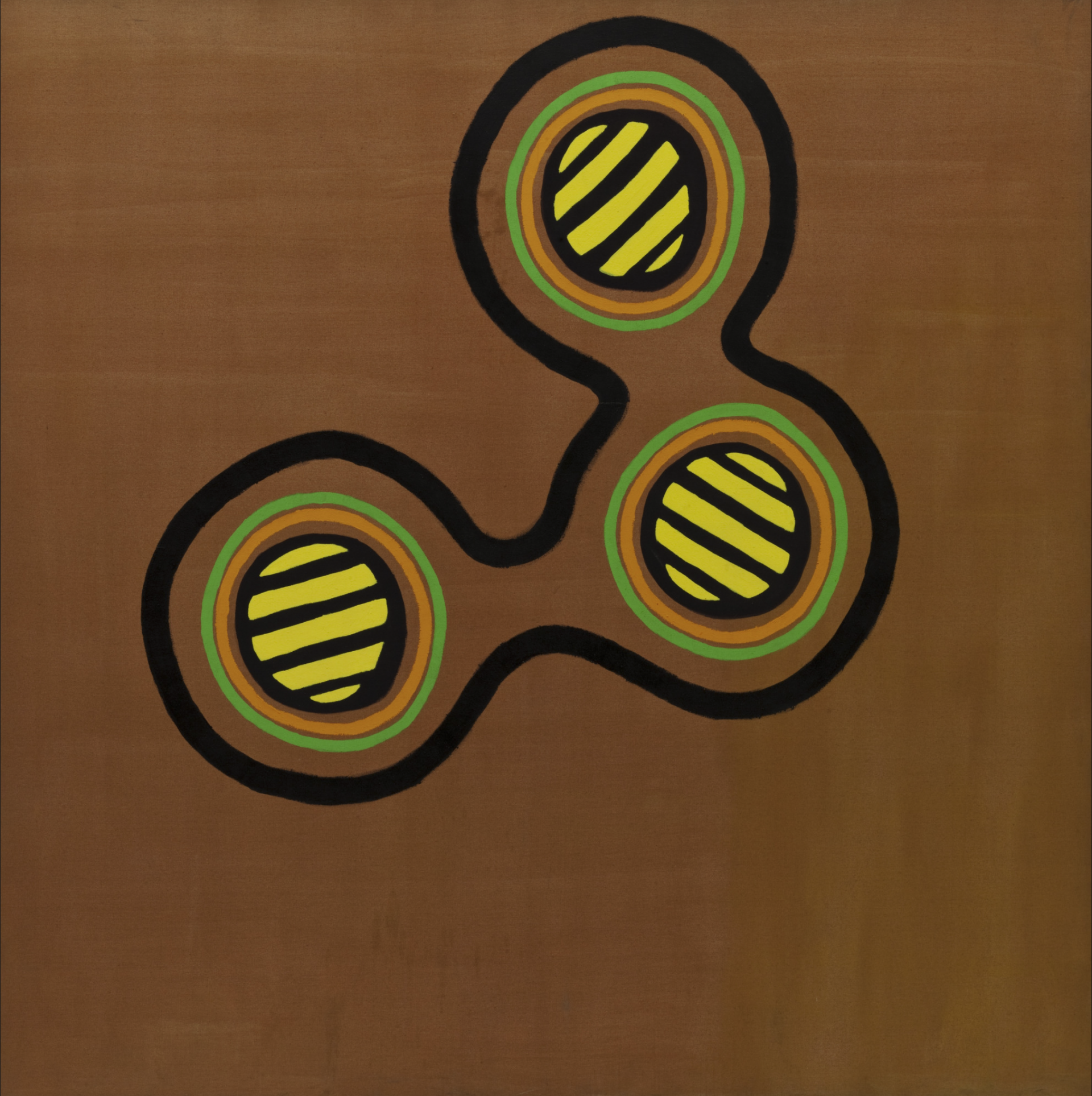
“The Whole World Has Gone Surfing” by Edward Avedisian, painted in 1963, is an exemplary work featuring a 3-spot triangular composition. The painting showcases three circular forms connected by a meandering black line, creating a triangular path across the canvas. Each circle, with parallel yellow stripes and encircled by rings of green and orange, is set against a warm brown background. This arrangement establishes harmony and visual stability, allowing the viewer’s eye to move fluidly from one circle to another along the implied lines of the triangle. The vibrant colors within the circles lend a dynamic quality to the piece. Avedisian’s pop art sensibilities are reflected in the painting, resonating with the cultural themes of the 1960s and the symbolism of surfing as a representation of freedom and youth.
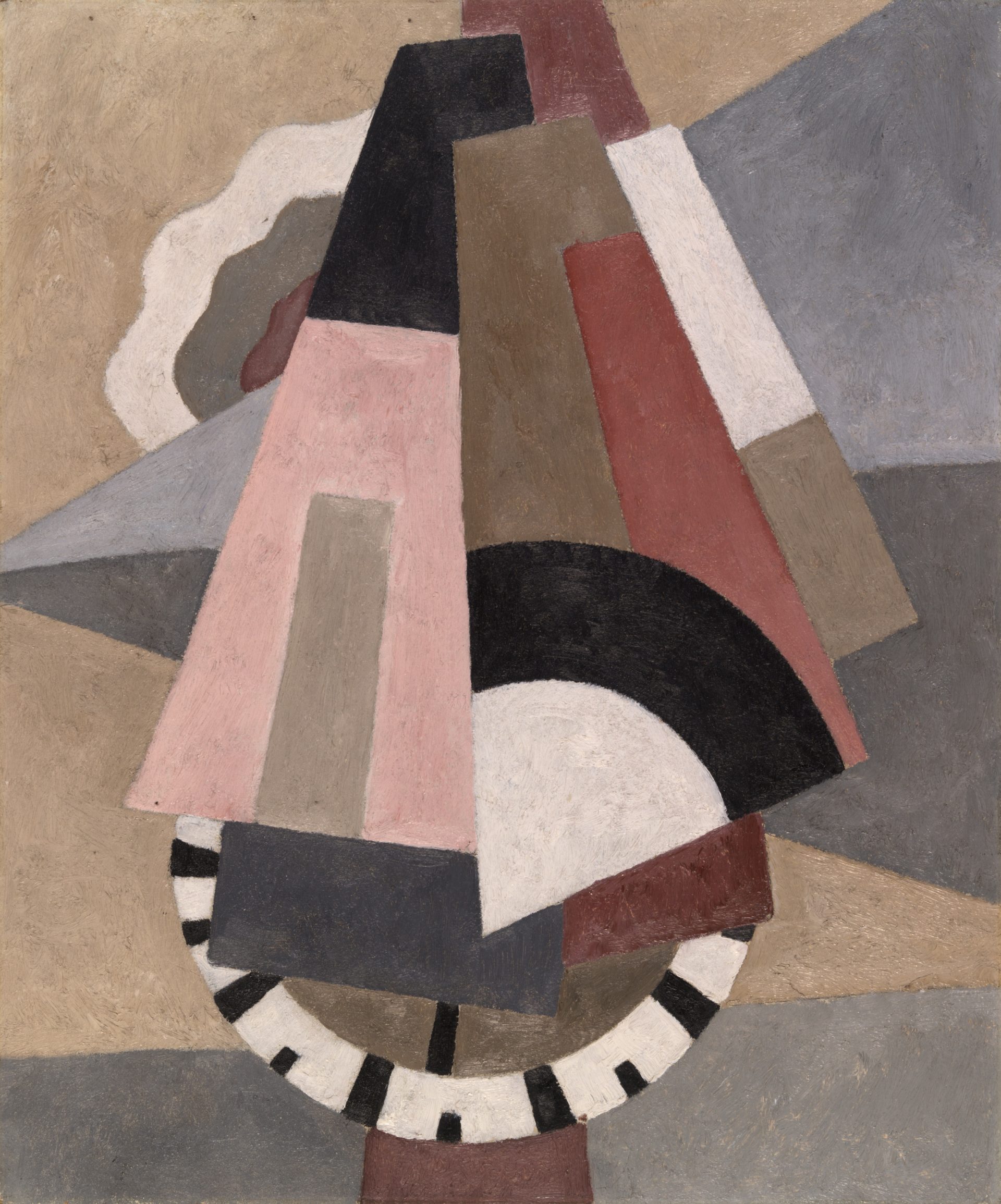
“Provincetown” by Marsden Hartley, created in 1916, is another abstract painting that utilizes a triangular composition. It features interlocking geometric shapes, suggesting a triangular arrangement within the canvas. Key elements include a large black semi-circle at the base, a pink triangle, and various shapes in muted tones. The visual connections between these forms create a sense of coherence and balance, with the striped semi-circle anchoring the composition and the other shapes appearing to hover above. Hartley’s work reflects the modernist approach to deconstructing traditional forms into basic geometric components. “Provincetown” invites viewers to explore the spatial relationships between the shapes, with the triangular composition providing structural integrity.
The L or rectangular composition in abstract art is a technique that uses L-shaped or rectangular arrangements to guide the viewer’s eye through the canvas. This compositional style can create a sense of structure, depth, and spatial harmony, allowing for a dynamic interplay between form and space.
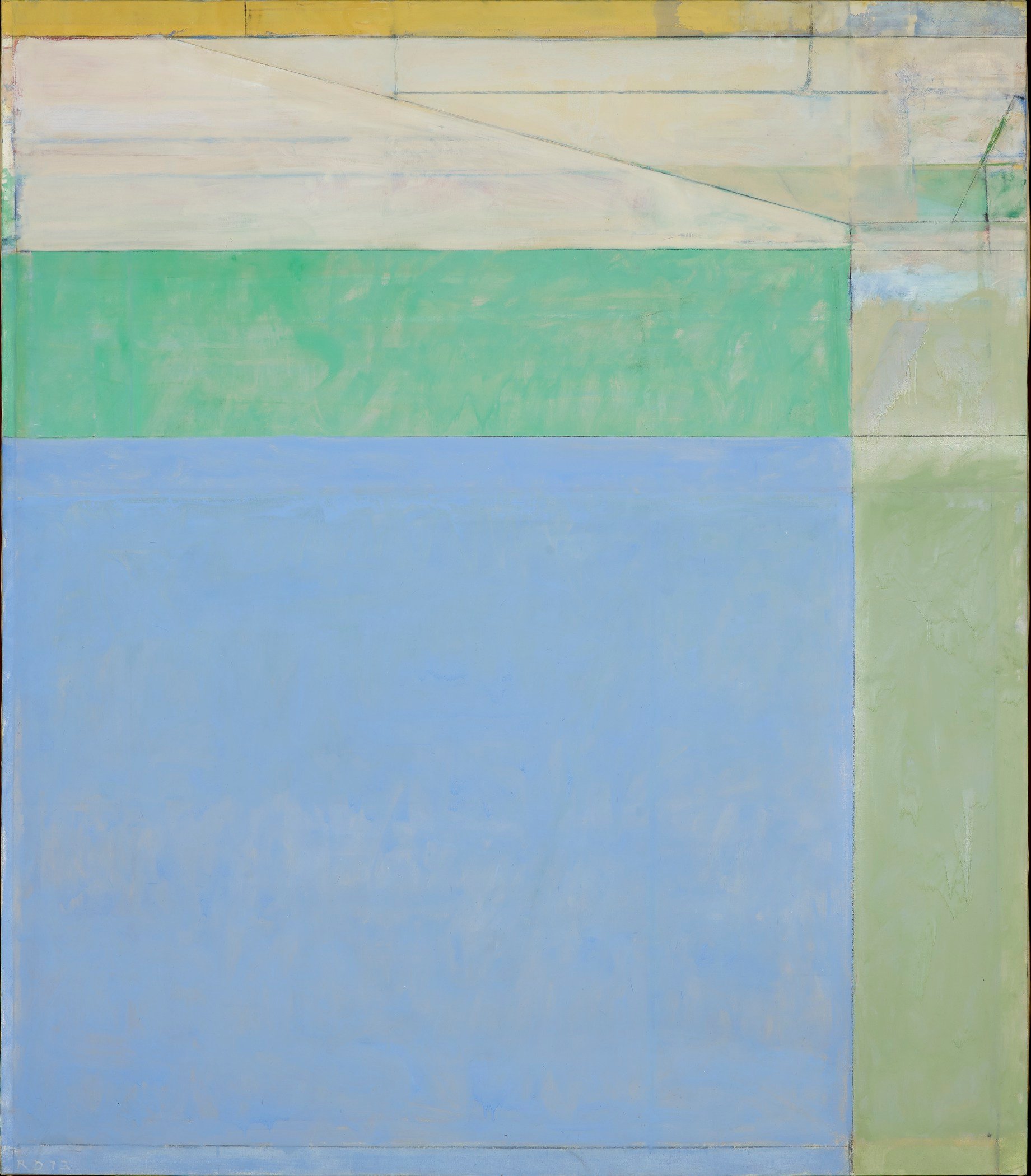
“Ocean Park No. 66” by Richard Diebenkorn, created in 1973, is a notable example from his Ocean Park series that demonstrates the use of an L or rectangular composition. The painting features sections of flat, rectangular color fields, creating a geometric and harmonious arrangement. A large blue rectangle occupies the lower half of the canvas, evoking feelings of calmness and expansiveness. This central blue area is framed by other rectangular shapes in pale green, muted yellows, whites, and greens, forming an inverted L shape around the blue space. Diebenkorn’s characteristic linear markings delineate the boundaries between the color fields, adding structure to the composition. The L or rectangular composition in “Ocean Park No. 66” offers architectural solidity and spatial depth, reflecting the landscape and urban environment of Ocean Park in Santa Monica.
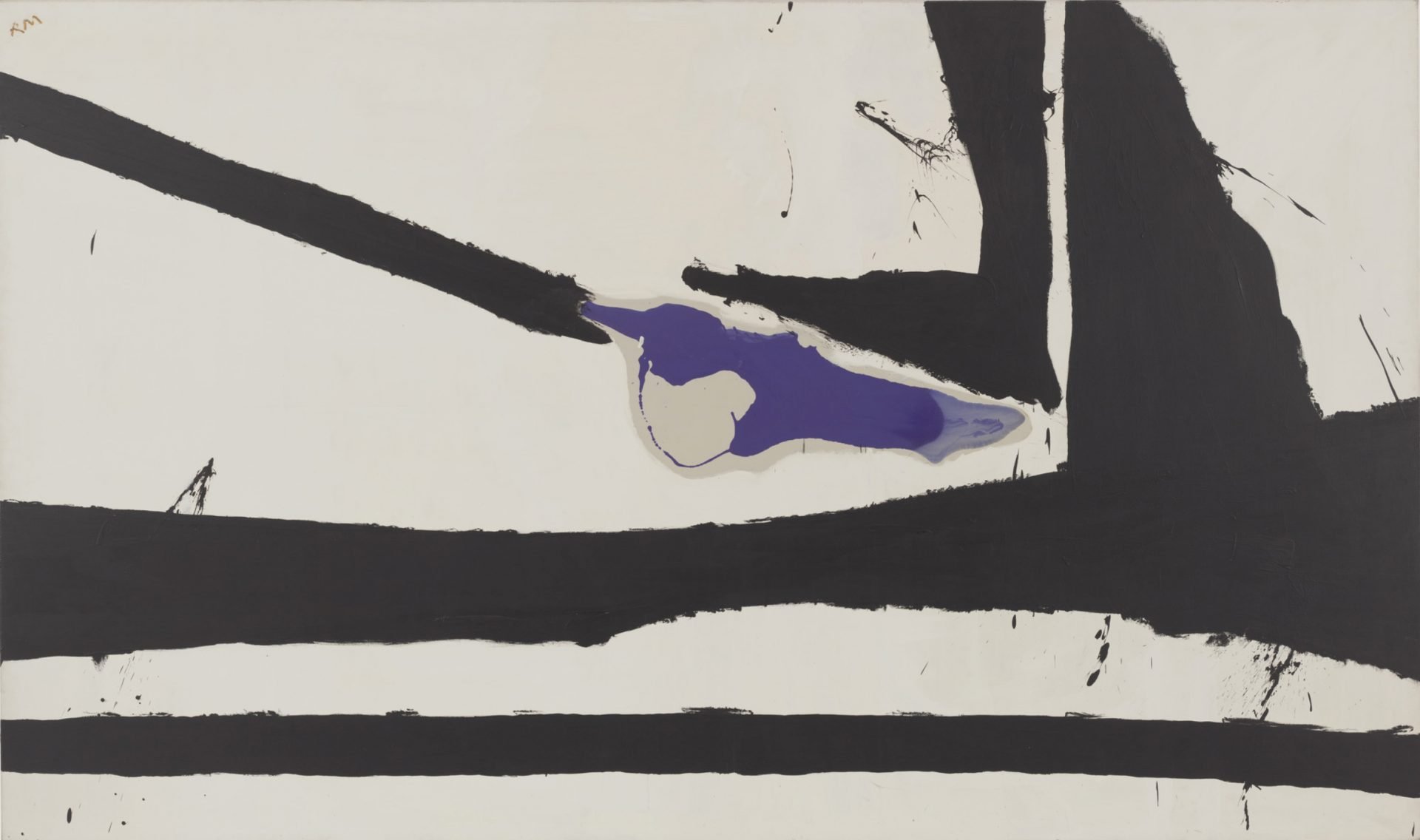
“New England Elegy 2” by Robert Motherwell, painted between 1965-66, is another abstract expressionist work featuring an L or rectangular composition. The painting is characterized by bold black brushstrokes that create horizontal and vertical forms, forming a powerful L-shaped motif. The black forms contrast against the white background, with splatters of paint adding texture. A singular blue shape within the black forms introduces color and serves as a focal point. Motherwell’s “New England Elegy 2” uses the L or rectangular composition to create tension and balance, with the juxtaposition of solid forms and negative space resulting in a dynamic and contemplative visual experience. The elegiac title reflects the solemn mood of the painting, conveyed through the simplicity and expressiveness of the forms and colors.
Tunnel composition in abstract art is a technique that creates an illusion of depth and perspective, guiding the viewer’s eye through a tunnel-like passage within the canvas. This approach often uses central, receding forms surrounded by framing elements, creating a sense of three-dimensionality and leading the viewer into an imagined space beyond the physical boundaries of the artwork.
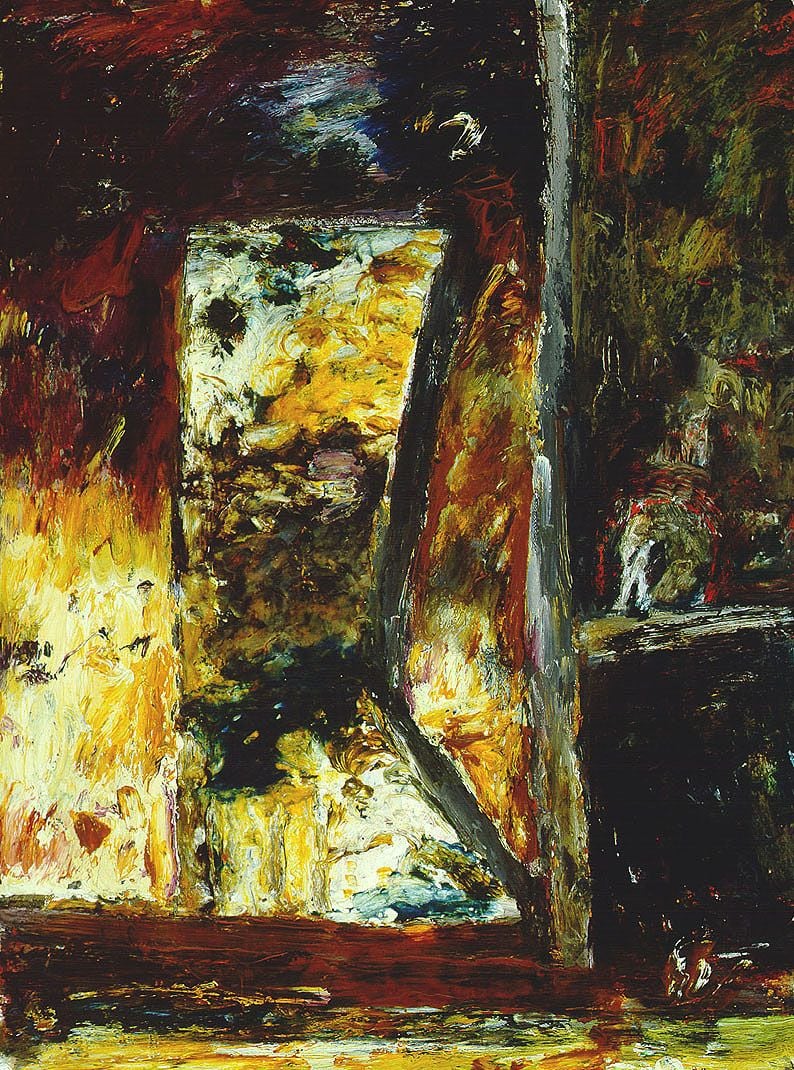
“Transpacifica Study No. 8” by John Walker, created in 1984, is a compelling example of an abstract painting with a tunnel composition. The work features a central, dark passage that draws the viewer’s eye into the depths of the canvas, resembling a tunnel. The surrounding forms and colors frame this passageway, enhancing the sense of depth and perspective. The brushwork is rich and dynamic, with deep reds, browns, and blacks contrasting against lighter, golden yellow areas that suggest illumination. The gestural intensity of the paint application adds texture and movement, reinforcing the illusion of a three-dimensional tunnel. Walker’s use of the tunnel composition may symbolize a journey or transition, evoking themes of time, transformation, or the unknown. The painting invites viewers to embark on a visual journey through the corridor, leading to an imagined space beyond.
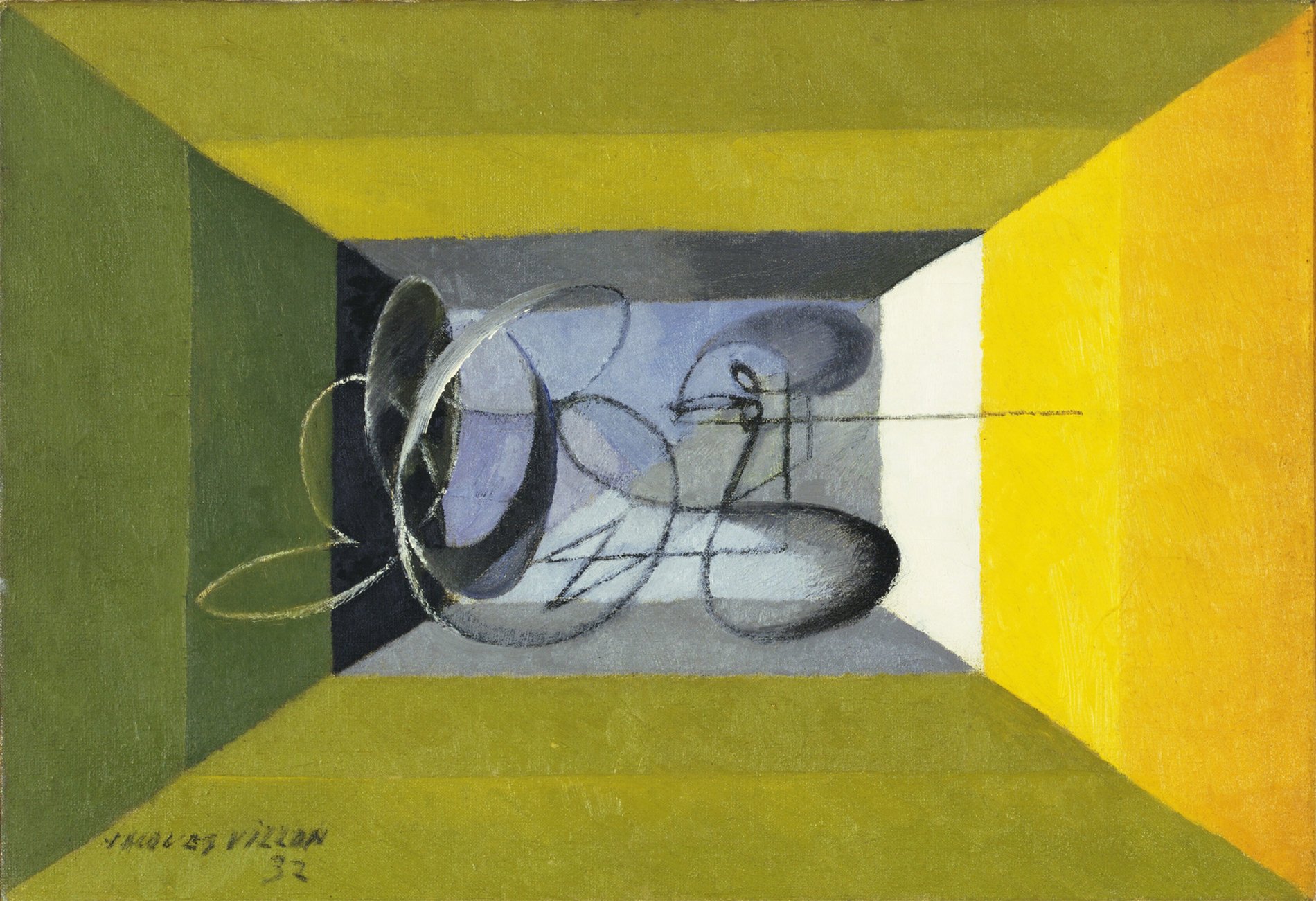
“Dance” by Jacques Villon, painted in 1932, also incorporates a tunnel composition in an abstract setting. The painting features a central, receding geometric form that creates the illusion of a tunnel-like space. This form is flanked by bold, angular shapes in contrasting greens and yellows, framing the tunnel opening and enhancing the sense of depth. The shading and perspective within the central form, along with the vibrant colors and outlines of the surrounding shapes, contribute to the sensation of peering through a passageway. Villon’s Cubist influences are evident in the geometrical abstraction and linear qualities of the painting. “Dance,” with its title suggesting movement and rhythm, may imply a connection between the visual elements and the dynamic nature of dance. The tunnel composition could represent the fluidity and transformative experience of movement, inviting the viewer to engage with the work’s spatial dynamics and the abstract representation of motion and music.
Pattern composition in abstract art is characterized by the repetition and rhythm of patterns, creating a rich visual experience through systematic yet dynamic arrangements. This compositional style often involves the meticulous application of motifs, exploring themes of order, chaos, and the interplay between them. Patterns in abstract compositions can vary in complexity and style, ranging from geometric forms to more organic shapes, and are used to create depth, movement, and texture within the artwork.
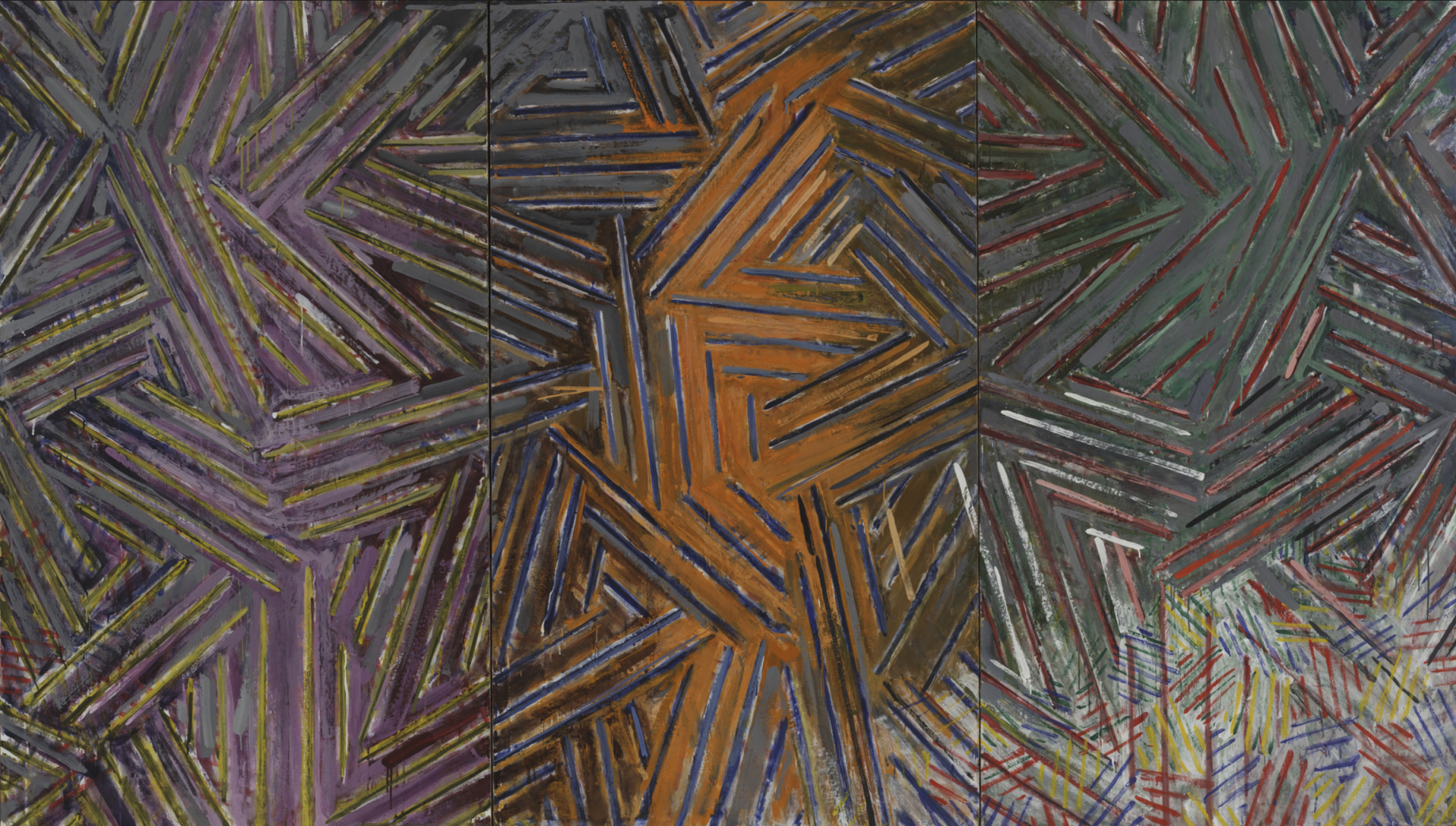
“Between the Clock and the Bed” by Jasper Johns, painted in 1981, is a quintessential example of pattern composition. The painting is divided into three panels, each densely filled with cross-hatched lines that form a textured tapestry. The panels feature different dominant color schemes: purples and pinks in the first, oranges and browns in the center, and greens and reds in the last, with blue and yellow accents throughout. Johns’ exploration of cross-hatching as a means to investigate literalness, repetition, and the balance between order and randomness is evident in this work. The cross-hatch pattern, while systematic, creates a visual field that is both orderly and chaotic, as the intersecting lines generate a pulsating energy. The title suggests themes of time and existential contemplation, with the repetitive pattern symbolizing the ongoing rhythm of life. Johns’ pattern composition invites viewers to find meaning in the repetitive motif and to reflect on the tension between the mundane and the significant.
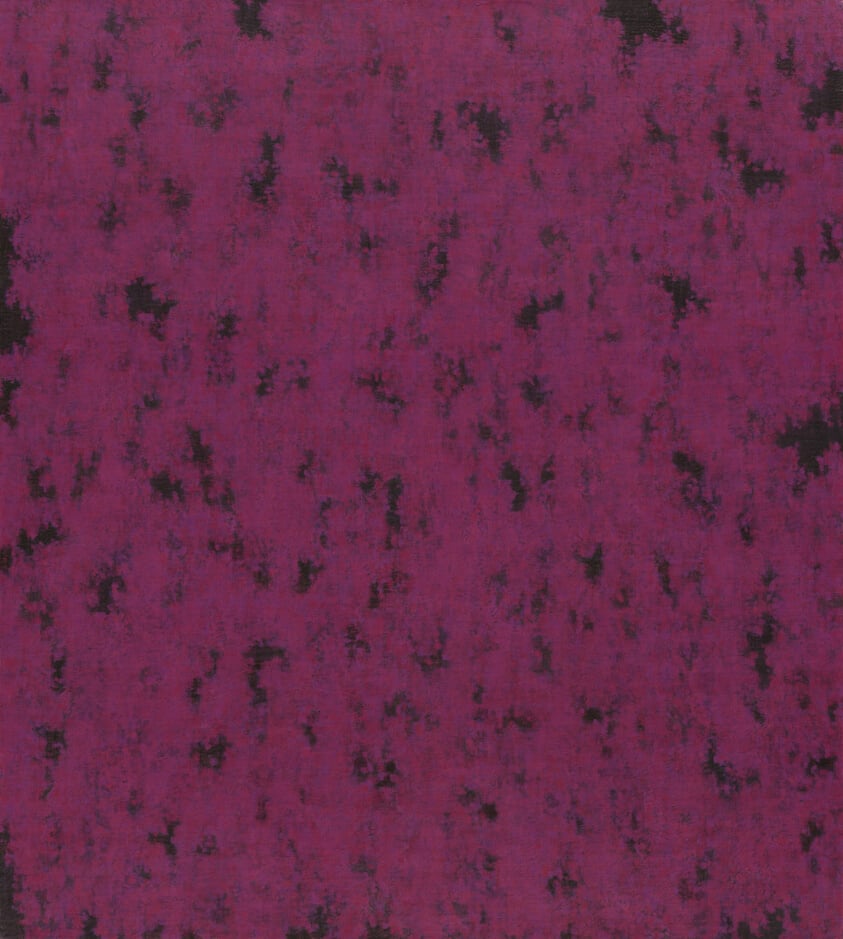
“Bloom” by Julia Fish, created in 1989, is another example of an abstract work employing pattern composition. The canvas is saturated with deep magenta and lavender tones, interspersed with dark green marks suggesting vegetation. The pattern of paint creates a dynamic visual field, with forms appearing to rise and sink within the picture plane. Fish’s technique of layering horizontal and vertical brushstrokes builds a textured surface that simulates organic growth, reminiscent of a garden at dusk. The painting captures the sensory experience of observing nature as daylight fades, with the repeated brush marks and gradual layering of paint contributing to a sense of change and impermanence. “Bloom” oscillates between clarity and ambiguity, reflecting the complexity and beauty of the natural world. The work invites viewers to immerse themselves in its tactile richness and to consider the influence of light and shadow on visual perception.
O or circular composition in abstract art focuses on the use of circular forms, which can symbolize various concepts such as wholeness, continuity, and infinity. Circular compositions often create dynamic visual experiences by drawing the viewer’s eye around the canvas in continuous motion. These compositions can evoke the rhythmical and cyclical patterns found in nature and the universe, making them powerful tools for abstract expression.
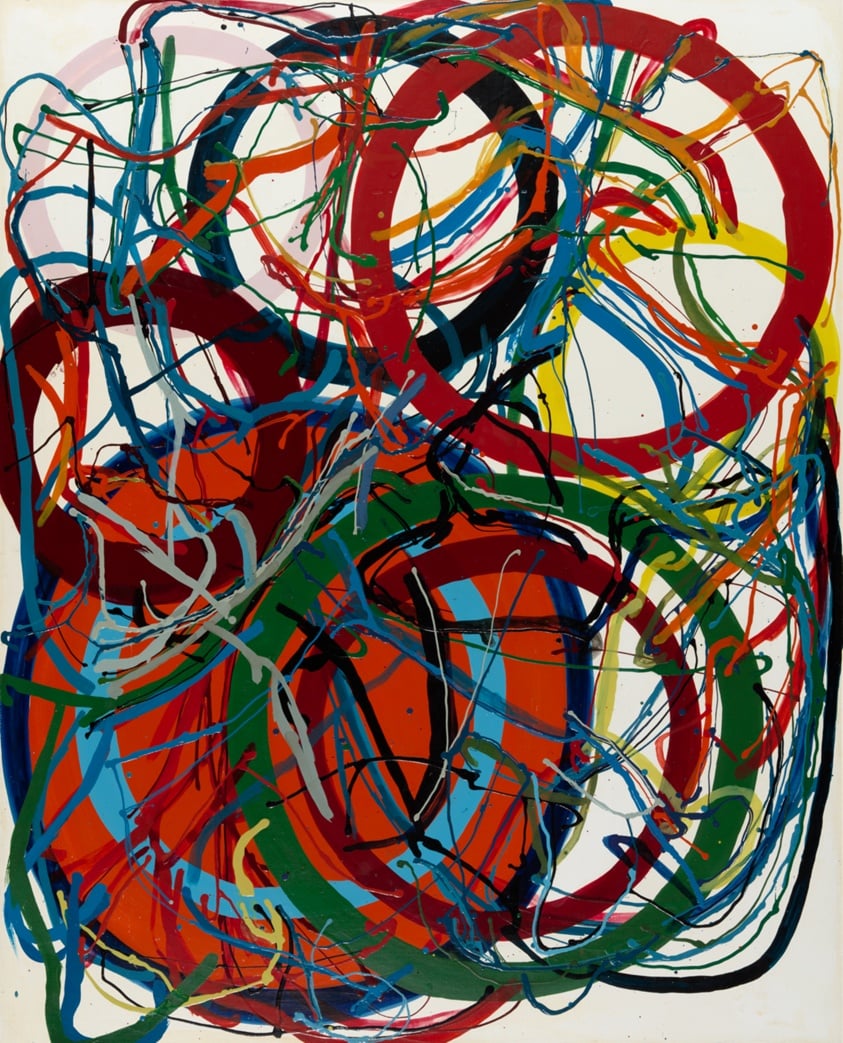
“Untitled” by Tanaka Atsuko, painted in 1964, is an abstract expressionist painting that exemplifies the use of an O or circular composition. The artwork features intertwined loops and circles in bold, gestural lines that sweep across the canvas in vibrant red, blue, green, yellow, and black. The looping lines and circular forms interlace to create a network that seems to pulsate and vibrate, suggesting movement and energy. Atsuko’s interest in connectivity and the infinite is reflected in this composition, where the circles become a metaphor for the interconnectedness of life and the limitless nature of artistic expression. The painting’s abstract form and title, “Untitled,” encourage viewers to interpret the work personally and find resonance within the tangle of shapes and colors.
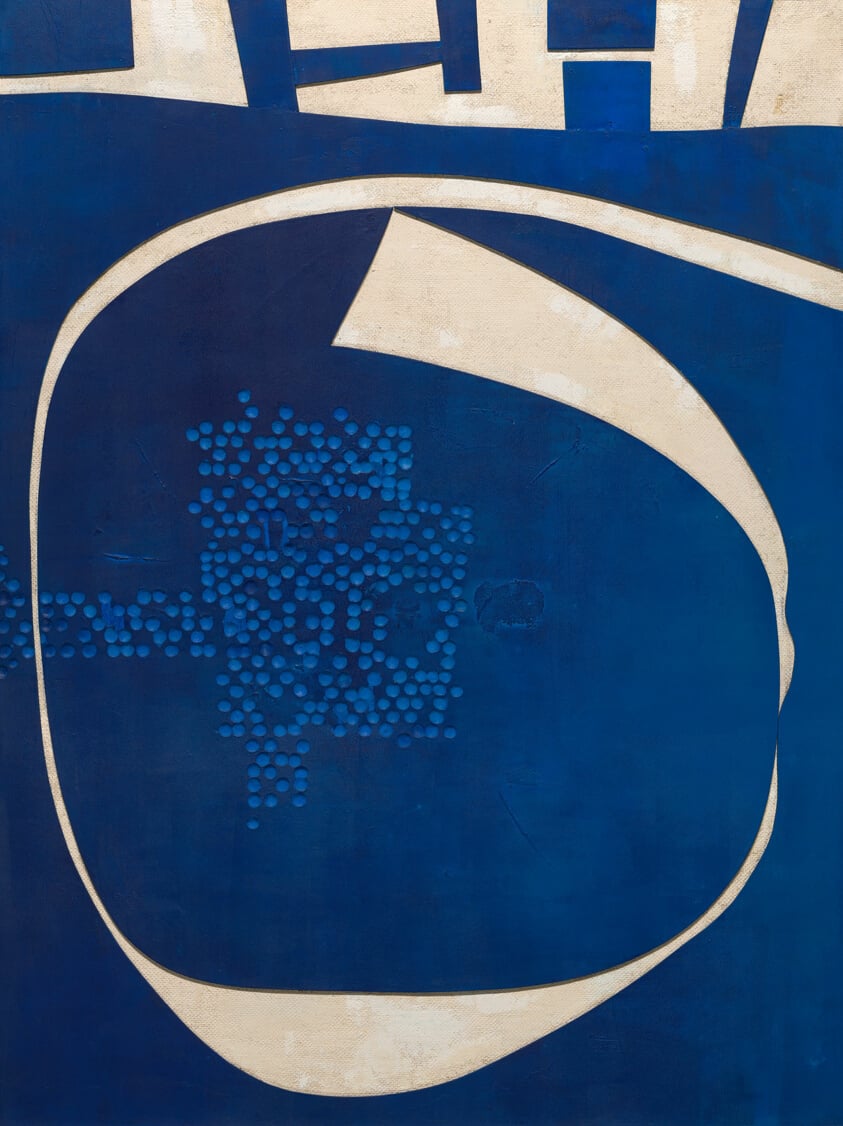
“Untitled” by Saitō Yoshishige, created in 1965, centers around an O or circular composition. It showcases a prominent off-white circle set against a deep blue background, with a cluster of smaller blue circles partially overlaying it. This arrangement suggests movement and a focal point of energy. The larger composition includes angular and rectilinear shapes in off-white that frame the central circle, emphasizing its presence. Saitō’s exploration of space and form is evident in the play of geometric shapes and the juxtaposition of circular forms within a structured environment. The painting’s minimalist aesthetic and central circular composition create a sense of harmony and order, characteristic of mid-20th century modernism. It invites viewers to contemplate the balance and rhythm between simplicity and complexity in forms and their relationships within the canvas.
The S or compound curve composition in abstract art is characterized by the use of flowing and elegant curves that create a dynamic visual experience. These compositions often evoke natural forms and movements, drawing the viewer’s eye through the canvas in a rhythmic and graceful manner. The interplay of curves and counter-curves in these compositions can suggest depth and dimensionality, adding to the complexity and richness of the artwork.
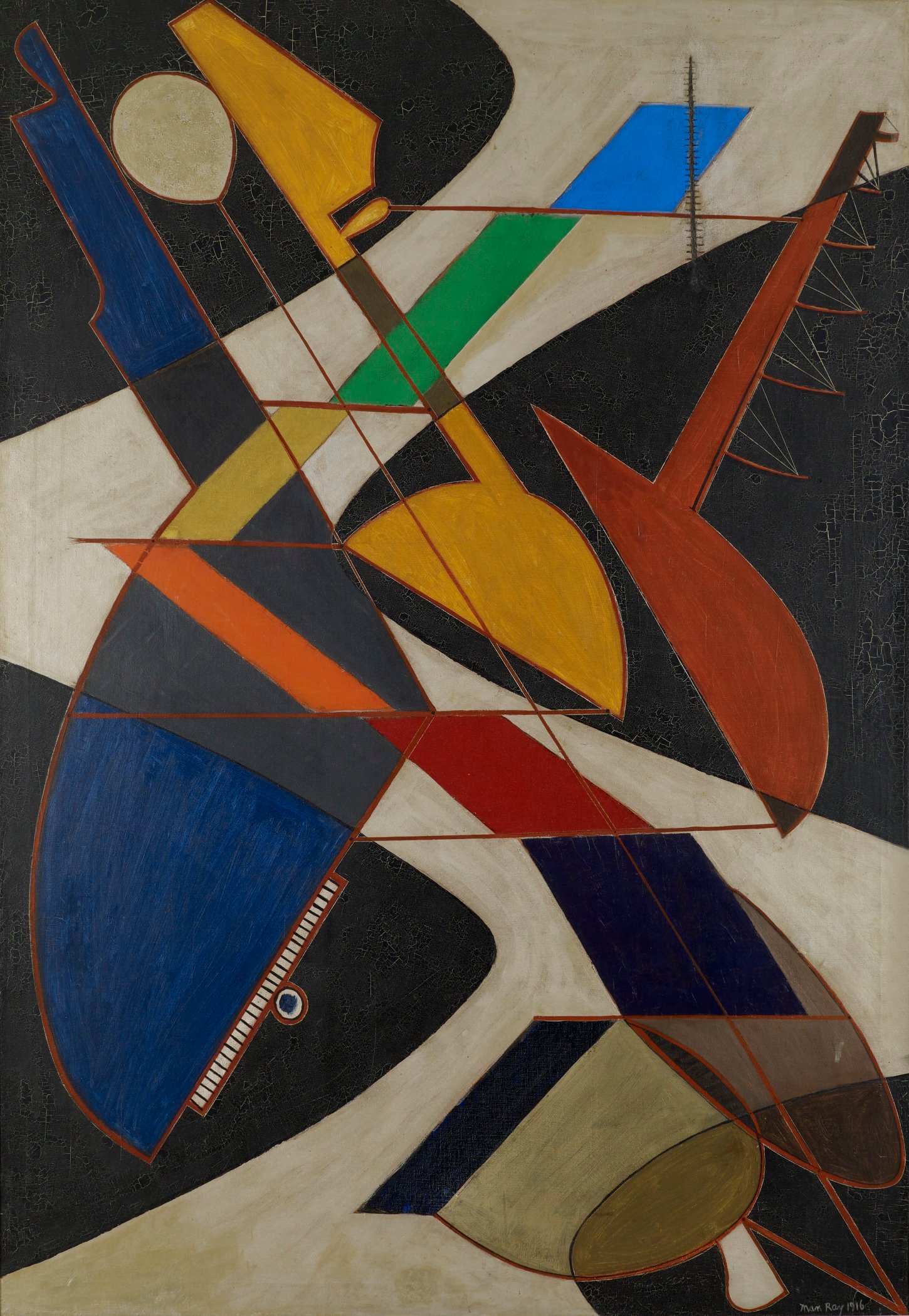
“Symphony Orchestra” by Man Ray, created in 1916, is an abstract work that demonstrates the use of an S or compound curve structure. The painting presents a dynamic arrangement of geometric shapes and curved forms that intertwine and overlap, creating a sense of rhythm and harmony. The diverse color palette includes bold shapes in blue, yellow, green, red, and orange, accented by softer hues against a dark background. The lines and curves guide the viewer’s eye in a sinuous path, reminiscent of the flow of an S shape. The composition suggests the interplay of musical instruments and the layered complexity of an orchestral piece. Man Ray’s innovative approach to form and his fusion of art and life are evident in this work, with the S or compound curve composition serving as a visual metaphor for the ebb and flow of melodies in a symphony.
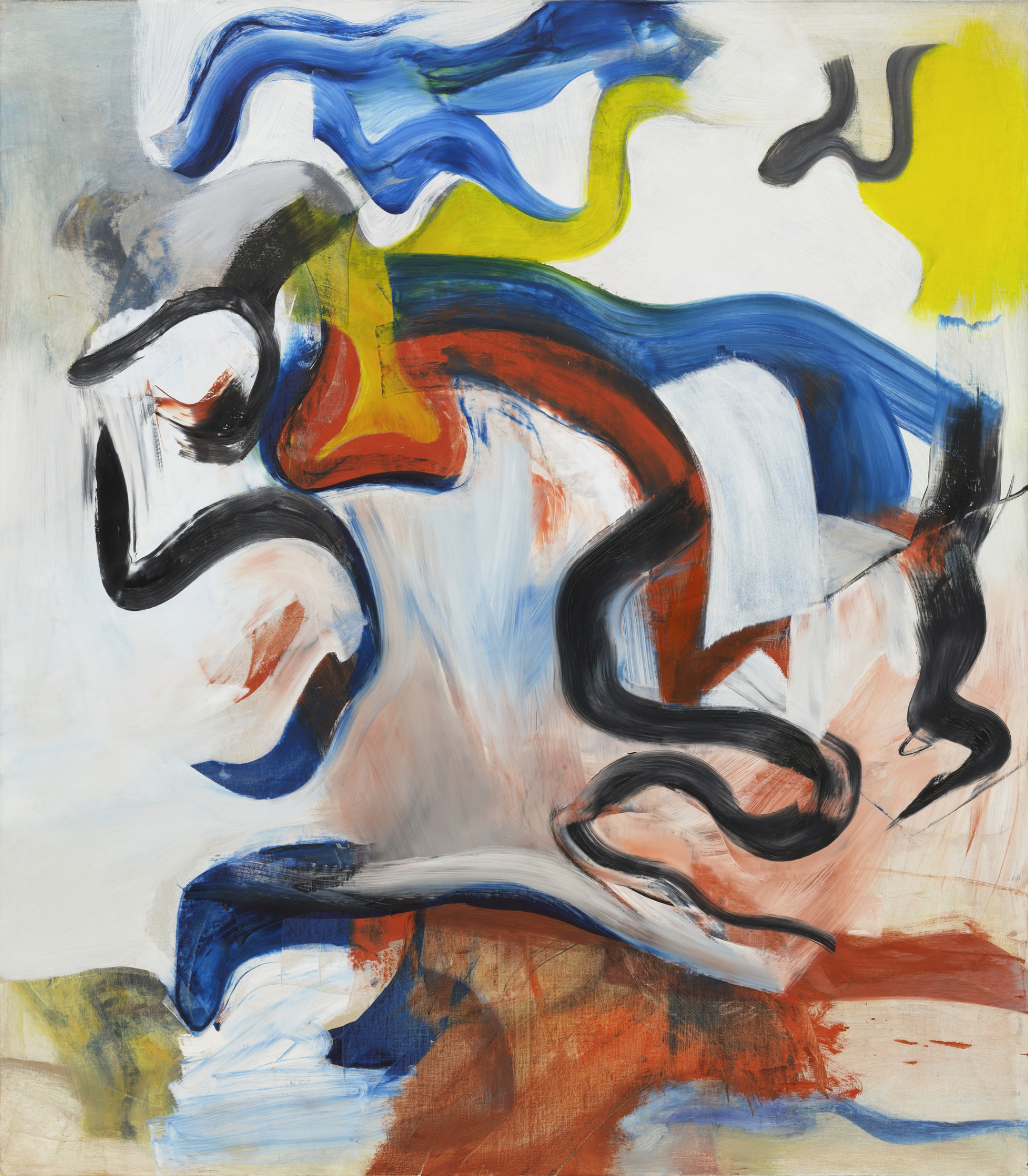
“Untitled V” by Willem de Kooning, created in 1982, exemplifies an S or compound curve composition in abstract painting. The artwork features swirling and meandering forms with fluid lines that suggest spontaneous movement. De Kooning’s vivid color palette, with blues, yellows, reds, and blacks, curves and intersects against a lighter background, suggesting depth. The rhythmic curves and layered, textured brushwork convey dynamic energy and emotional intensity. The composition evokes natural forms and movements, such as the flow of water or the contours of a landscape, while remaining open to interpretation. De Kooning’s use of compound curves creates a visual language that challenges traditional pictorial space.
V arrangement composition in abstract art involves the use of V-shaped forms or the convergence of lines and shapes at a point, creating a dynamic sense of movement and direction. This compositional style often evokes the force and energy inherent in the V shape, guiding the viewer’s eye and emphasizing the directional pull within the artwork.
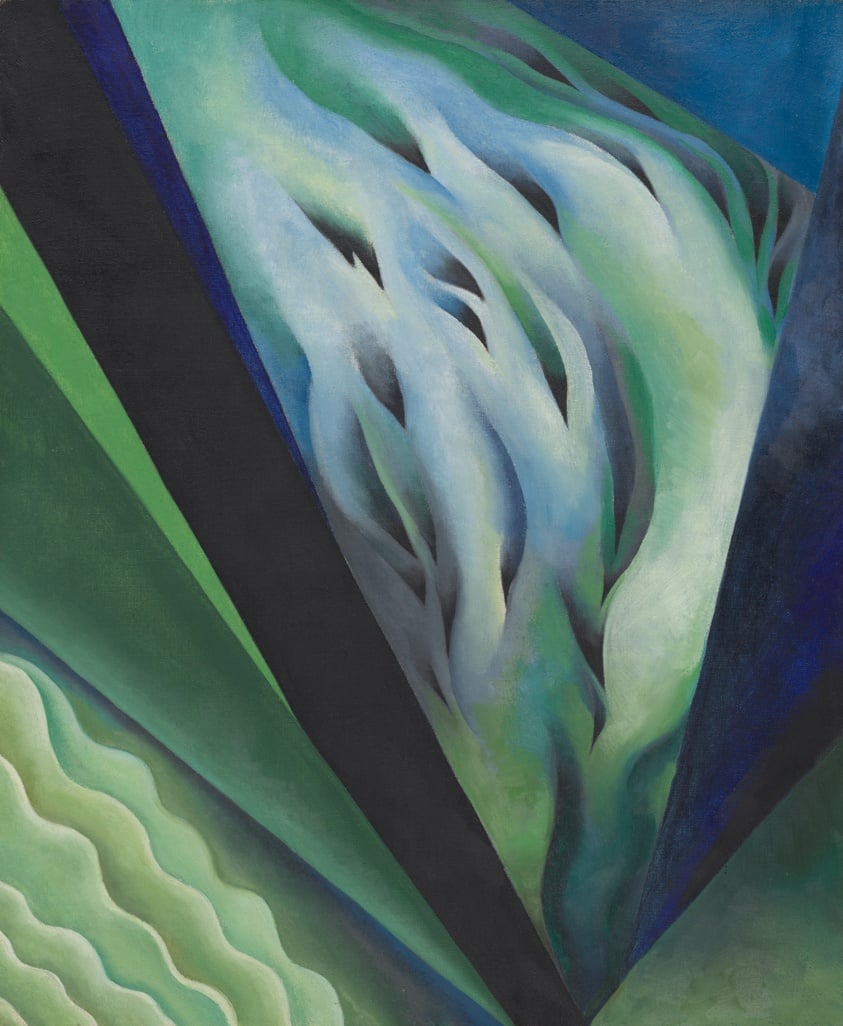
“Blue and Green Music” by Georgia O’Keeffe, created between 1919 and 1921, is a striking example of a V arrangement composition. Influenced by the theories of Vasily Kandinsky, O’Keeffe attempts to translate music into visual art in this painting. The convergence of lines and shapes at a point in the composition mirrors the structure of a musical chord or melody. O’Keeffe employs a palette of blues and greens to create fluid forms that undulate across the canvas, reminiscent of musical notes and rhythms. The interplay of colors and shapes is harmonious, suggesting the sublime in both the natural world and music. The abstract forms appear to rise and fall, and the V arrangement anchors the composition, providing structure and direction. O’Keeffe’s exploration of the synesthetic relationship between sight and sound results in a visual symphony, inviting viewers to ‘hear’ the colors and ‘see’ the music.
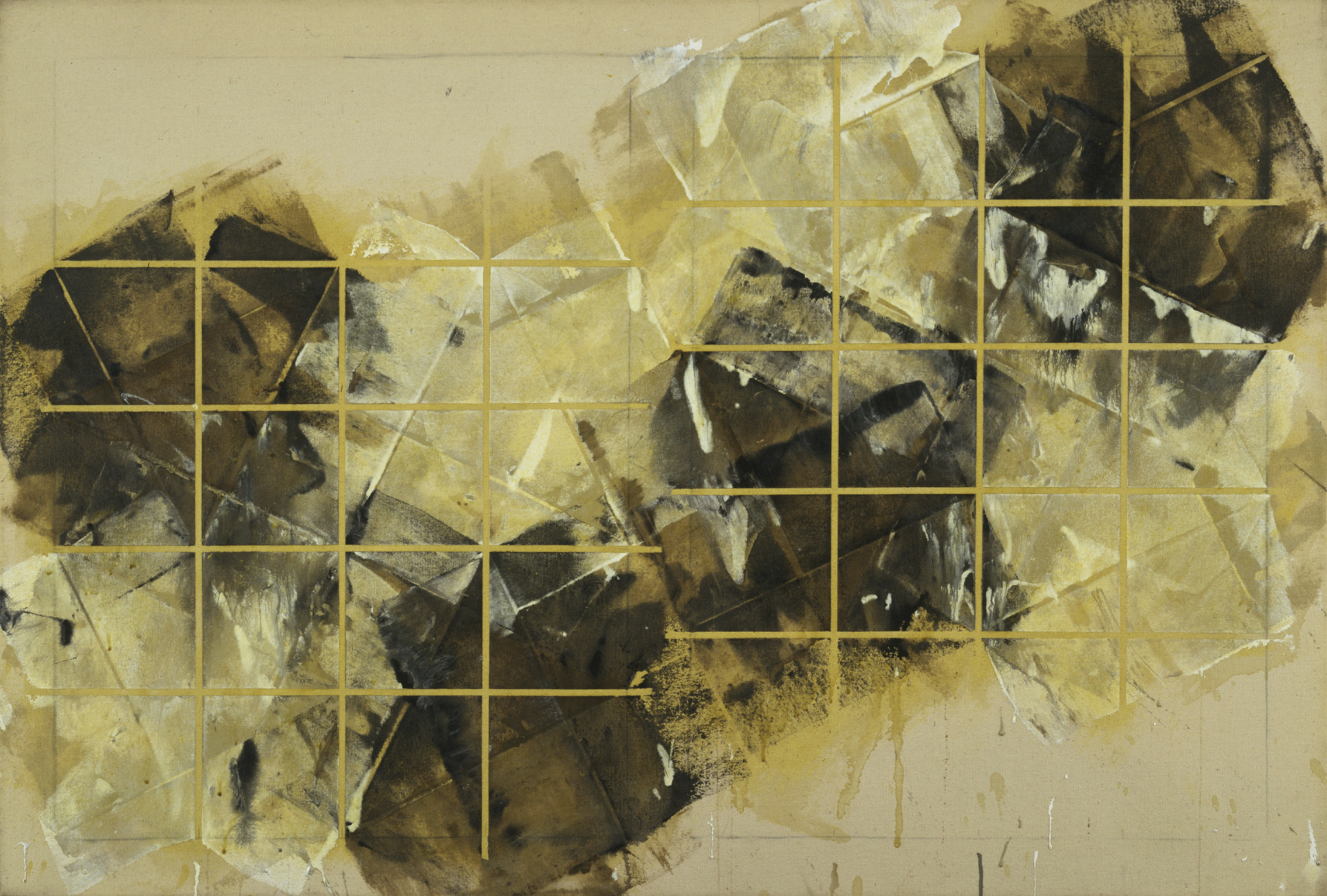
“14th Street Series Number 9” by Mark Lancaster, painted in 1972, also embodies a V arrangement composition. The painting features a grid of shapes that collectively form a larger V shape. This technique creates a strong directional force, guiding the viewer’s gaze across the painting. The warm color palette, with shades of brown and yellow, adds earthiness, while black and white elements within the squares provide contrast and depth. The overlay of grid lines offers structure and order. The painting reflects on form and space, where the V composition structures the work visually and imparts a sense of stability and balance, despite the dynamic angles of the individual elements. It balances abstraction with geometric precision, prompting reflection on the relationship between the parts and the whole.
Throughout this exploration of various compositional styles in abstract art, we have seen the diverse and innovative ways artists employ form, color, and line to convey emotion, concept, and narrative. From the balanced harmony of cruciform and horizontal compositions to the dynamic tension of diagonal and V arrangements, each style offers a unique lens through which to view the abstract world. The elegance of S or compound curves, the depth of tunnel compositions, and the rhythmic repetition of pattern compositions are just a few examples of how abstract artists manipulate visual elements to create impactful and engaging artworks.
One of the key takeaways from this examination is that abstract art is not confined to a single compositional approach. Artists often combine multiple compositional concepts, blending styles to achieve a more complex and layered visual experience. This versatility allows for a rich mosaic of expression, where the interplay of different compositional elements can evoke a broad range of emotional responses and intellectual reflections.
The importance of composition in abstract art cannot be overstated. It is the foundation upon which artists build their visual language, guiding the viewer’s eye, and shaping their perception of the artwork. Composition is what gives abstract art its depth and resonance, allowing viewers to connect with the work on a personal and emotional level. The effectiveness of an abstract painting often lies in its composition, as it is through this orchestration of form and space that artists communicate their vision and invite viewers to explore the realms of imagination and interpretation.
